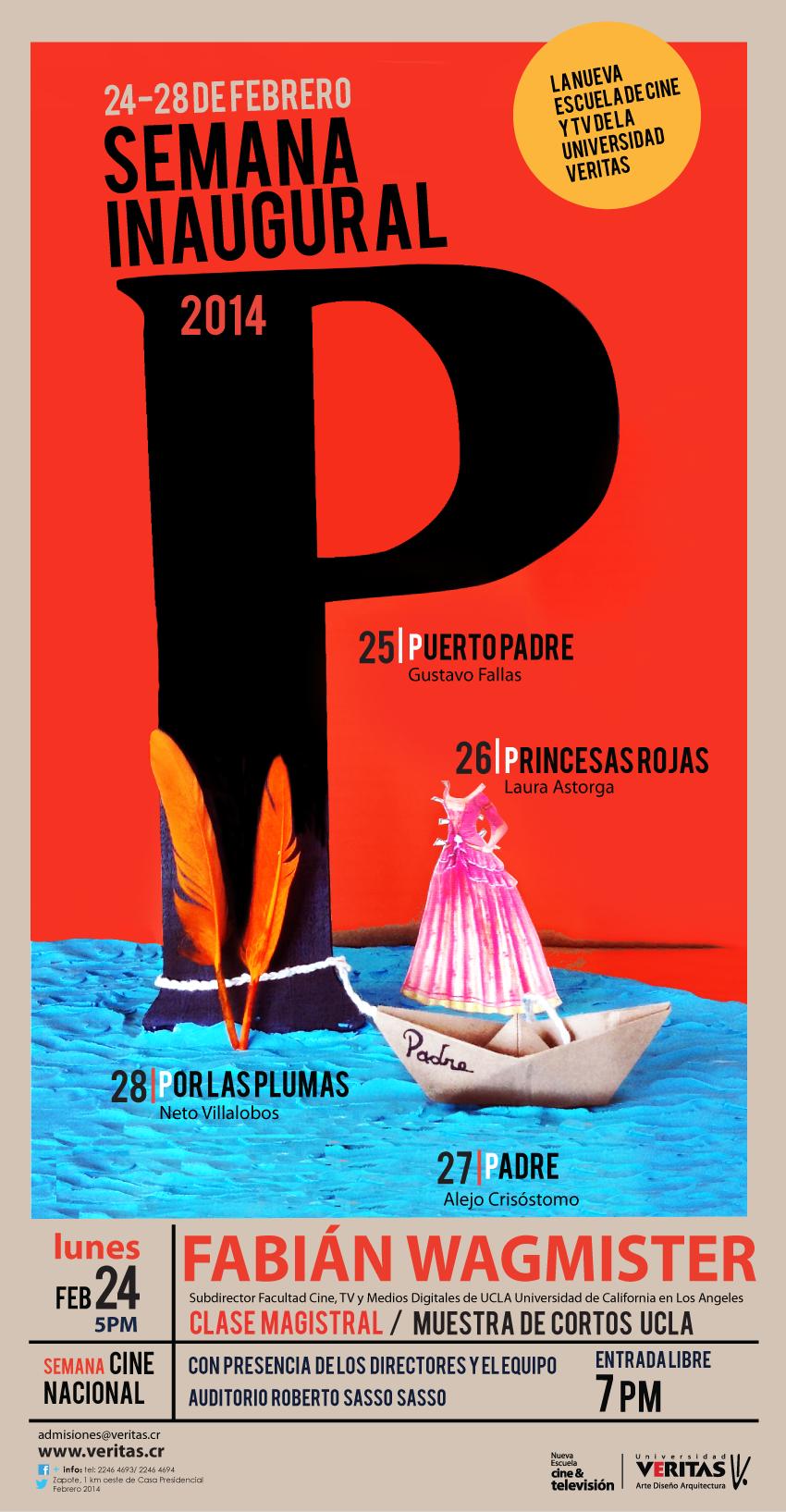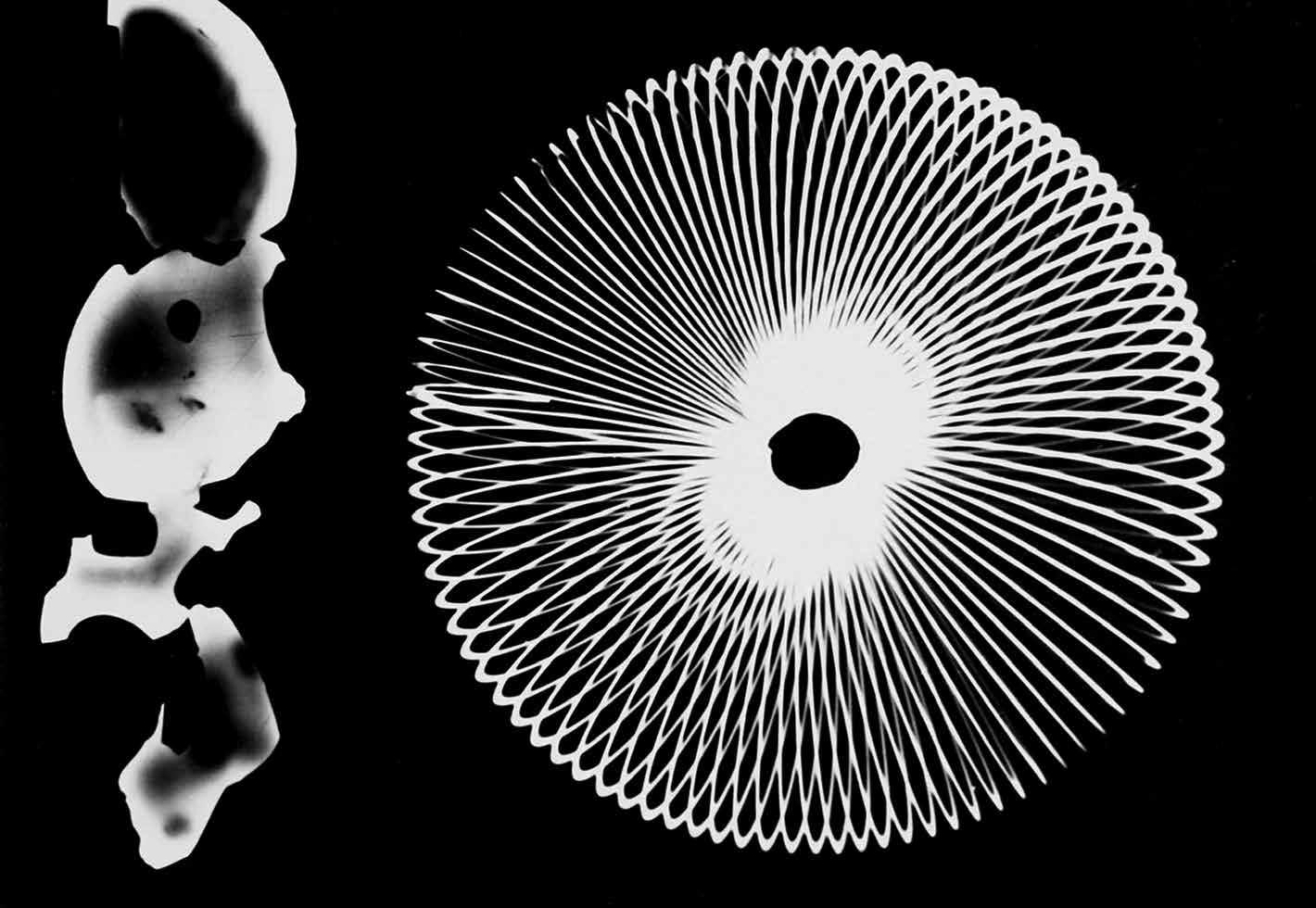
59 minute read
Paneles 7-12
INSTALLATIONS AND EVENTS
lIst of Works anD events
Advertisement
Cellar (Basement)
Room 2 Halla Steinunn Stefánsdóttir, I Play Cement, 2017-19 video installtion with binaural audio
Room 3 Vanessa Farfán, Model 5052 (from Machines with Organs) video installation
Presidential Room (1st Floor)
Patricia Smith and Sarah K. Stanley, Bureau for Cartographic Assemblages workshop
Red Room (2nd Floor)
On piano Niamh Schmidtke, Plane No. 7 (Hip Height) perspex Niamh Schmidtke, The Homeless Line paper
On table Yota Passia & Panagiotis Roupas, Hecate//Non Visible City paper, wire, plexiglass
Left Wall Guro Sollid and Kristine Annabel Torp, Untitled I, II Inkjet colour prints
Computer Fabian Wagmister, Becoming Flow~Desire Interactive website
halla steInunn stefánsDóttIr
Lund University, Sweden
I Play Cement, 2017-19
Halla Steinunn Stefánsdóttir, performance, field recording, composing, mixing and video editing Kent Olofsson, mastering
I Play Cement connects to a larger body of works that explore movement, listening and navigation and is the second work within Stefánsdóttir‘s “Activation series.” The series draws on the relational technique of multi-entity performance (Rawlings 2019, Stefánsdóttir 2019), which informed the later stage of composition at Lund University’s Inter Arts Center in Malmö, Sweden.
The footage of ‘I play cement’ was filmed and recorded in summer and winter 2017–18, as Stefánsdóttir navigated through an abandoned cement factory, situated by the mouth of Elliðaár river in Reykjavík, Iceland. “I play cement” was originally created for Dark Music Days 2018 edition in Iceland and has in its video and 8 speaker format also been shown at “Carbon Ruins — an exhibition of the fossil age” in Lund, Sweden. It is shown here in a binaural version, specially created for DARE.
vanessa farfán
Bauhaus University, Weimar, Germany
Machines with Organs: Model 5052
The Portuguese man o‘war (or Australian blue bottle) is a colonial organism in the genus Physalia. Its body consists of individual animals (polyps) that have joined together. The individual polyps are specialized on certain tasks and form an organism together. Taking as a reference the structure of the Portuguese man o‘ war and inspired by Manuel Delanda‘s interpretation of Deleuze/Guattari’s Assemblage Theory, my current artistic research focuses on the possible structural forms that allow new interactions between organs (as human and non-human agents) in a Machine with Organs (MwO).
A MwO is a dynamic system with flexible nodes. It is an analogue machine that has been created based on a long, slowly and maybe infinite algorithm. Composed by biological- (e.g., human), physical- (e.g., electricity) and digital agents (e.g., computer language), a MwO is not an object but a system that can be codified and re-codified by operating it.
Model 5052 is my first attempt to create a MwO. Model 5052 is an analog-trivial machine, which was designed and built from digital information. Like a rhizomatic structure or a basic form of algorithmic geometry, the process to conceive this machine could be describe in terms of recursivity where contingency has a place (Yuk Hui, 2019).
Model 5052 runs on an electric motor, lead pellets, gravity and graphite paper. The machine Model 5052 is neither the “final product” nor the creator of the artwork. The machine and its output are only two steps in the process to obtain, by means of an aesthetic interpretation of the contingency: concrete forms of what is possible.
The process of creation of the machine is a complex composition of materials, actions and circumstance in which several artworks have been (and could be) emerge. The whole process including artworks and steps, could be perceived as a single artwork: a complete artwork (Gesamteskunstwerk). In this autopoietic model the machine Model 5052 play the role of a trigger, whose aesthetic quality of synthesis (typical of any model) accelerates the interaction process between different forms of binary segmentation: male / female, calculability / unpredictability, encode / decode, input / output, mechanic / organic.
PatrICIa sMIth & sarah k. stanley
Visual Artist, Rotterdam, The Netherlands / Theorist, Art Writer, London, UK
Bureau for Cartographic Assemblages
Make a map, not a tracing. The orchid does not reproduce the tracing of the wasp; it forms a map with the wasp, in a rhizome. What distinguishes the map from the tracing is that it is entirely oriented toward an experimentation in contact with the real. The map does not reproduce an unconscious closed in upon itself; it constructs the unconscious. It fosters connections between fields, … It is itself a part of the rhizome. The map is open and connectable in all its dimensions; it is detachable, reversible, susceptible to constant modification. It can be torn, reversed, adapted to any kind of mounting, reworked by an individual, group, or social formation. It can be drawn on a wall, conceived of as a work of art, constructed as a political action or as a meditation . . . it always has multiple entryways. (A Thousand Plateaus, 13)
The impetus to participate in a research event involves desire for embodied connection, to affect and be affected. The Bureau for Cartographic Assemblages will create a type of secondary platform (the orchid forms a map with the wasp) in order to experiment with the politics (and poetics) of enunciation. We ask, can connections across urban sites be made with the Orpheus Institute and its activities, and this Machinic Desire research forum? Following Broodthaers’s hybrid media project Voyage on the North Sea, we will present textual mappings in mixed tape formats, a large canvas mapping exercise and live recitations. From these elements, we arrange ‘soundings’, conceptual tracks made and remade through cartographic assemblages. Our in-situ decompression station will seek to form close relations with the research forum, becoming imperceptible with its activities as therapeutic medium.
Bureau de la Géographie Intérieure was located at 34 rue Gutenberg in Paris from January 20 to February 19, 2017. Patricia Smith’s storefront mapping project made use of selections from S.K. Stanley’s recent published research that experiments with urban cartographies in Berlin, making use of Walter Benjamin’s unfinished Paris Arcades Project. This cartographic production was generated by the act of physically exploring and charting surrounding ecologies and incorporating documentation from those who chose
to interact with it. Our sited installation at the Orpheus Institute will extend this and other projects, making use of mapping and textual inscriptions as an actual manifestation of assemblage theory. Cartographies will arise and fall from fragments of conversation, lines from presentations offered as well as opportunities to arrange or encounter these materials. Some lucid dreams from Ghent, London, Rotterdam and North Sea passages will also fill in parts of this map. Please join us.
Patricia Smith is a visual artist who investigates the process of mapping through drawing, sited installations and performance projects. Her work has been engaged with the writings of Deleuze and Guattari and the Situationists since the mid-90s. Smith has exhibited throughout the United States and Europe, including recent exhibitions at Krasj 4 Ninove in Ninove, Belgium, Hans Körnig Museum in Dresden and a dream mapping project for the town of Bienno, Italy. She was a 2014 recipient of a New York Foundation for the Arts fellowship and has been awarded residencies from Cité Internationale des Arts in Paris and Kaus Australis in Rotterdam. She has been represented by Front Room Gallery in New York City since 2006. www.patriciasmithart.com
nIaMh sChMIDtke
Goldsmiths, University of London, London, Uk
Plane No.7 (Hip Height) and The Homeless Line
The root of my practice is to expose and understand the gap between financial capitalism and our everyday “lived” economies. There are many problems with this subject matter, three of these problems - the scale of our economies; statistics as a visualisation tool; and how such data can become graspable – inform the construction of the two works on display, Plane No.7 (Hip Height) and The Homeless Line. With these works I intend to show that artistic interventions can open a space within which it becomes possible to have a meaningful dialogue about our economies.
The first problem is that we live inside our economies; they are so large that they have become invisible to us. This system is so all-encompassing that we don’t even realise that this is happening. It is simply impossible to gain a full picture of our economy, yet unless we strive to just that it will remain invisible to us. Timothy Morton’s theory of Hyperobjects (2013) is valuable here; he describes an object that is massively distributed in time and space, relative to humans (2013, 1). The difficulty of “trying to evoke the objectness of hyperobjects,” as Morton puts it, is that they are ‘primordially in their being prior to thinking” (Morton, 2013, 20). He proposes that one way to visualise these hyperobjects is by abstracting them through statistics.
However, statistics exist on flat and immaterial planes and show the world from a cold and “non-local” perspective; art production lends itself more fully to the problem of evoking the objectness of economy as a hyperobject. This led me to examine Gilles Deleuze’s theories of planes and rhizomes, within his co-authored book with Félix Guattari, A Thousand Plateaus (1987). Their thoughts on capitalism as a ‘crossroads of all kinds of formations.’ (Deleuze, 1987, 20), led me to a new understanding of the ways we investigate our economies. Using this image of the multiplicities of capitalism I began critically investigating the structure of a rhizome, as something that “connects any point to any other point” (21). In order to deconstruct the language within A Thousand Plateaus, I used drawing as an instinctual translation and application of their concepts into my visual language. By applying rhizomatic thinking I could dismantle the way we view statistics through a series of investigative drawings which aimed at deterritorialising the flatness of statistical data.
Working through drawing resulted in sections of statistical data being materialised into a series of planes. Over time planes can be added or removed, allowing the object to change with our economy and to never be complete. Plane No.7 (Hip Height) is made from bright yellow Perspex, which not only references that statistical line is was determined from, but also the slick, and commercial displays of capitalist economies. The language of commodity production is used to make a statement about the invisibility of our economies
Whilst working through the problem of how to materialise this statistical data I was also grappling with the third problem: how the work might be graspable for a viewer. Returning to A Thousand Plateaus, I explored how Deleuze and Guattari discussed capitalism as existing in “all kinds of formations” (20), or put in another way, as existing in multiplicities. This led to the simultaneous production of another work. Taking the view of the rhizome as something that is “always detachable, connectable, reversible, modifiable and has multiple entryways and exits and its own line of flight” (21). I began using the book as an object with a particular set of codes; a beginning, middle and end, a set of pages, a cover etc… By using a recognisable format, I was able to more explicitly show how rhizomatic thinking could modify objects. As a result, this book, The Homeless Line, breaks ideas down into planes. Acting as a series of 3D folds, each plane of thought is allowed to exist and connect through the viewer’s interaction. The process of ‘reading’ the work plays with the process of making, physically manifesting how the sculptural object was conceived and formed. When this object exists with the sculptural work, there is more encouragement for the viewer to interact and ‘play’ with the meaning of the piece. The dynamic dialogue between the objects allows the work to exist in multiples, as each work is reconfigurable and has many access and exit points, both to the viewer and to one another. Through a process of deterritiorialising and reterritorialising each other, the works exist in a state of tension and becoming.
yota PassIa & PanaGIotIs rouPas
studioentropia architects, Athens, Greece
Hecate // Non Visible City
The complexity of information hinders one’s cognition and knowledge. Hecate is organizing the city’s layers of significance while at the same time translating them into geo-referenced intensities. As the city’s multi-layered informational content is constantly changing, Hecate monitors its sociospatial metabolism in real-time, pointing to the city’s islands of affordances. It is visualized as a network of richly interconnected nodes of varying intensities, each representing information flows between the system and the city. Hecate has the performance capacity of an elastic urban fabric that associates and disassociates, controls, determines and consumes both existing and emerging urban structures. It is an interactive cityscape, a new map of the territory, in constant flux. This piece identifies, interprets and represents the non-discrete relational fields to both make them visible and understand their presence, intensity, and variation in the organization of space. Here, space is described as a connectionist model by means of the representation of the interconnections of its parts but without any of its parts.
Guro sollID & krIstIne annabell torP
The Royal Danish Academy of Fine Arts, Copenhagen, Denmark
Untitled I and II
Alongside our presentation, we show two large scale cartographic drawings (110 x 220 cm). The cartographic drawings are different positions in the same iterative process, like siblings or mirror images of each other. The complexity manifests itself in the accumulation of iterative layers, of acts of adding or subtracting information. The drawings’ qualities and limitations are tested in their ability to identify difference and to function as notational diagrams. The diagram is not considered a representation of a reality yet is rather self-producing by virtue of its abstraction.
The survey is part of an ongoing artistic research practice that investigates the architectural drawing’s ability to configure new morphological entities, and that recognizes the architectural drawing as an essential tool for creative reflection. In various attempts to expose, mask and yet again reveal latent potential, the drawings are constructed and disassembled in continuous movement.
Like Marcel in the final sentences of In Search of Lost Time considers his friends as monsters of time, as they suddenly appear to him as assemblages of simultaneously present layers of selves, like “giants immersed in Time,” so we see our drawings; as monstrous landscapes trying to escape the quantitative captivity of space, in order to grasp the possibilities of interspace – of time and movement.
fabIan WaGMIster
PedaLúdico, Buenos Aires, Argentina and REMAP-UCLA, Los Angeles, United States
Becoming Flow~Desire
An instrumented cycling assemblage drifts for nine days exploring its potentialities and capacities for movement along the meanders of the Guayas River estuary in Ecuador. The desire to flow freely, to be movement, is guided by and negotiated with the natural and social vectors of the territory. Movement is assumed as a territory-specific, esthetic language and the shape of the evolving meander articulates the assemblage’s identity and its evolving improvisational composition. Like water the bike assemblage is characterized by a high degree of plasticity, the potentiality for change based on the dynamic forces and relationships configuring it (machine, rider, roads, topography, weather, other moving things, etc.). To explore this fluid plasticity, the cycling assemblage seeks constant contact and connection with the bodies of water present in the territory. To follow water, to cross water, to enter water, to become water.
The bicycle and the cyclist are densely instrumented to register data and media that generate an interpretive cartography of the “becoming-bike” assemblage and its transformative flow. A project-specific app records location and the dynamics of movement, and relates these with a set of aesthetic tools used by the rider to express the improvisational encounter with the here and now. An iconographic marker set, a color palate, texts and images are all integrated into a synchronous map exhibited live at the Museo de Antropologia y Arte Conteporaneo (MAAC) in Guayaquil, at the Centro Hipermediatico Experimental (cheLA) in Argentina and at the DARE conference in Belgium. The map can also be seen online at: http://practicasdeperiferia.org/mapa/ mapa.html
The project integrates art research, experimentation, production and exhibition into a unified assemblage framework. To deepen this convergence of traditionally separated stages of art making visitors to the project’s simultaneous interpretive cartography exhibition in Ecuador, Argentina and Belgium can engage in live texting sessions with the rider. To dialog with the rider during the project’s drifting go to: http:// practicasdeperiferia.net/Becoming-Flow-Desire
Becoming Flow~Desire is part of the larger territorial collective creation project Prácticas de Periferia. Co-created by PedaLúdico and Centro Rural de Arte of Argentina and
produced with support from Pro Helvetia’s Coincidencia program and a broad coalition of cultural institutions, Prácticas de Periferia enables intersecting drifting projects by Argentinean, Ecuadorian, and Swiss artists. As co-director of Prácticas de Periferia Fabian Wagmister created the digital toolset used by these artists to research, interpret and communicate the moving dynamics of their drifts.
While highlighted in the DARE 2019 exhibit because of its focus on assemblage and its Deleuzian theoretical framework Becoming Flow~Desire is intrinsically weaved with the other six drifting projects of Prácticas de Periferia. For more information about Prácticas de Periferia see http://practicasdeperiferia.net.
Artistic and Conceptual Background In 1956, Pablo Neruda wrote “Ode to the Bicycle” in which he poetically expresses the robust linkage between the bicycling and assemblage theory. In a remarkable use of language Neruda observes a machinic assemblage of desire composed of summer: “… the sun popped like a field of blazing maize, the earth was hot, an infinite circle with an empty blue sky above”; riders: “Workers and girls were riding to their factories, giving their eyes to the summer, their heads to the sky”; context: “… down a sizzling road..., as they rode by bridges, rosebushes, brambles and midday”; and bicycle. In their interrelations these components become “…the only insects in that dry moment of summer, silent, swift, translucent; they barely stirred the air”. It would be easy to simplify the metaphor and think of the moving bicycle/bicyclist as the insects but a careful reading of the poem supports the idea that Neruda is actually referring to the complex intersecting flows defining the here and now. Summer, heat, workers, girls, factories, sizzling roads, blazing maize, bicycle, all define the experiential assemblage both as lived and interpreted. The complexity and richness of this combined identity is reflected the final verses of the poem “… and fallen there it isn’t a translucent insect humming through the summer but a cold skeleton that will return to life only when it’s needed, when it’s light, that is with the resurrection of each day.”
Equally Deleuzian is the 1970 tango “The White Bicycle” by Astor Piazzolla and Horacio Ferrer. Told in first person as in Neruda’s poem, it narrates the story of an “… eternal cyclist, alone, so alone that [he] climbs the streets at night...” “Nobody knows, where in the heck he comes from, it is never known where the devil he goes”. He rides, and rides. And the tango tells us “Everyone, meanwhile, on the sidewalks rolling on the ground with laughter applauded him like crazy…” And this flow, at once assemblage of desire and enunciation composed of character, context, bicycle, city, citizens… ultimately results in “…one night, his horrible bicycle with trailer began to cast an enormous fluorescent tail. Unbelievable!”; a transformative force: “the pickpockets returning wallets, the powerful ending hunger, UFO revealing the mystery of peace…”.
Once again, the bicycle is a co-functioning component of a transformative flow, a becoming desire.
Inspired by these and other related artworks addressing the “become-bike” assemblage (apparatus, human, environment) I have undertaken a series of extensive performative bicycle drifts seeking to engage the type of aesthetic transformative flow of desire and enunciation expressed in the above examples. In two performances of the project Bicicletas Blancas, one involving a 6-night drift (sunset to sunrise) in Buenos Aires, and the other involving a 1000-kilometre drift through the Argentine Pampas I used sensing and interpretive technologies to observe and express the physical and social rhizomatic flows of each territory. Data about heartbeat, cadence, vibration, environmental color scheme, speed, and media about social encounters were composed in a real-time interpretive installation expressing the becoming-bike and creating a live interpretive cartographic expression of the resulting assemblage. Bicicletas Blancas: https://vimeo.com/253081792 Laboratorio PedaLúdico: https://vimeo.com/242678928 PedaLúdico: http://pedaludico.net
Acknowledgments Becoming Flow~Desire was made possible by the significant contributions of cheLA, CRA, PedaLudico, Funcando, REMAP, Prácticas de Periferia, Dara Gelof, Sur Wagmister, and Mapu Wagmister.
And the support of Pro Helvetia’s Coincidencia program, MAAC Museo de Antropología y Arte Contemporáneo (Ecuador), Fondo Nacional de las Artes (Argentina), Fondo Metropolitano de la Ciencia, la Cultura y las Artes (Argentina), édhéa École de design et haute école d’art du Valais (Switzerland), BienalSur UNTREF (Argentina), and Fundación exACTa (Argentina),
Keywords: becoming-bike, bicycling assemblage, interpretive cartography, situationist drifting, interpretive digital media, plasticity.
Fabian Wagmister is associate professor at UCLA’s School of Theater, Film and Television and is the founding director of the Center for Research in Engineering, Media and Performance (REMAP). He created and directs the Centro Hipermediático Experimental Latinomericano (cheLA) in Buenos Aires Argentina, an innovative research, experimentation and production project exploring the intersections of culture, community and technology. His work focuses on alternative technological modes for collective interpretive creativity. He collaborates with diverse communities to generate reflexive media systems emphasizing cultural and locative specificity. In this context technology and culture converge into a performative social practice of investigation and expression.
Fabian’s recent projects consider mobility as a defining factor of individual and collective identity. Inspired by a situationist and Deleuzian theoretical framework he seeks to defunctionalize movement in a diversity of urban and rural environments and transform it into a tool for creative research and creative expression. He combines extensive derive processes with interpretive cartography tools to generate collective works merging investigation, experimentation, and exhibition into a synchronous experience. Among his related projects are Imageability (2006), a participatory cognitive mapping installation about the history of Los Angeles, Engage Ludicity (2009), a collective urban détournement experience, Memoria Barrial (2012), a navigable media cartography installation in a Buenos Aires subway station and Bicicletas Blancas (2018), a situationist derive performance and installation about motility in the city.
Dare 2019: MaChInIC asseMblaGes of DesIre
third International conference on Deleuze and Artistic REsearch Orpheus Institute, Ghent, Belgium 9–11 December 2019
Conference Chair Paulo de Assis
Conference Coordinator Paolo Giudici
Editorial Board Paulo de Assis, (Orpheus Institute, Ghent, Belgium) Zsuzsa Baross (Trent University, Canada) Arno Böhler (University of Vienna, Austria) Henk Borgdorff (University of the Arts, The Hague, the Netherlands) Laura Cull (University of Surrey, Guildford, United Kingdom) Lucia D’Errico (Orpheus Institute, Ghent, Belgium) Mika Elo (University of the Arts, Helsinki, Finland) Paolo Giudici (Royal College of Art, London, United Kingdom) Julian Klein (Institut für künstlerische Forschung, Berlin, Germany) David Savat (executive editor of the Deleuze Studies Journal) Michael Schwab (editor in chief of the Journal for Artistic Research) Kamini Vellodi (University of Exeter, United Kingdom)
Organising Committee Paolo Giudici, Lucia D’Errico, Filipa Botelho, Daniela Fantechi, Juan Parra Cancino, Daphne Ronse, Kathleen Snyers, Heike Vermeire
Fabian Wagmister
PedaLúdico, Buenos Aires, Argentina and REMAP-UCLA, Los Angeles, US
Becoming Flow~Desire
Keywords: becoming-bike, bicycling assemblage, interpretive cartography, situationist drifting, interpretive digital media, plasticity.
An instrumented cycling assemblage drifts for nine days exploring its potentialities and capacities for movement along the meanders of the Guayas River estuary in Ecuador. The desire to flow freely, to be movement, is guided by and negotiated with the natural and social vectors of the territory. Movement is assumed as a territory-specific, esthetic language and the shape of the evolving meander articulates the assemblage’s identity and its evolving improvisational composition. Like water the bike assemblage is characterized by a high degree of plasticity, the potentiality for change based on the dynamic forces and relationships configuring it (machine, rider, roads, topography, weather, other moving things, etc.). To explore this fluid plasticity, the cycling assemblage seeks constant contact and connection with the bodies of water present in the territory. To follow water, to cross water, to enter water, to become water.
The bicycle and the cyclist are densely instrumented to register data and media that generate an interpretive cartography of the “becoming-bike” assemblage and its transformative flow. A projectspecific app records location and the dynamics of movement, and relates these with a set of aesthetic tools used by the rider to express the improvisational encounter with the here and now. An iconographic marker set, a color palate, texts and images are all integrated into a synchronous map exhibited live at the Museo de Antropologia y Arte Conteporaneo (MAAC) in Guayaquil, at the Centro Hipermediatico Experimental (cheLA) in Argentina and at the DARE conference in Belgium.
The map can also be seen online at: http://practicasdeperiferia.org/mapa/mapa.html
The project integrates art research, experimentation, production and exhibition into a unified assemblage framework. To deepen this convergence of traditionally separated stages of art making visitors to the project’s simultaneous interpretive cartography exhibition in Ecuador, Argentina and Belgium can engage in live texting sessions with the rider.
To dialog with the rider during the project’s drifting go to: http://practicasdeperiferia.net/Becoming-Flow-Desire
Becoming Flow~Desire is part of the larger territorial collective creation project Prácticas de Periferia. Co-created by PedaLúdico and Centro Rural de Arte of Argentina and produced with support from Pro Helvetia’s Coincidencia program and a broad coalition of cultural institutions, Prácticas de Periferia enables intersecting drifting projects by Argentinean, Ecuadorian, and Swiss artists. As co-director of Prácticas de Periferia Fabian Wagmister created the digital toolset used by these artists to research, interpret and communicate the moving dynamics of their drifts.
While highlighted in the DARE 2019 exhibit because of its focus on assemblage and its Deleuzian theoretical framework Becoming Flow~Desire is intrinsically weaved with the other six drifting projects of Prácticas de Periferia. For more information about Prácticas de Periferia see http://practicasdeperiferia.net.
Artistic and Conceptual Background:
In 1956 Pablo Neruda wrote “Ode to the Bicycle" in which he poetically expresses the robust linkage between the bicycling and assemblage theory. In a remarkable use of language Neruda observes a machinic assemblage of desire composed of summer: “…the sun popped like a field of blazing maize, the earth was hot, an infinite circle with an empty blue sky above”; riders: “Workers and girls were riding to their factories, giving their eyes to the summer, their heads to the sky”; context: “… down a sizzling road..., as they rode by bridges, rosebushes, brambles and midday”; and bicycle. In their interrelations these components become “…the only insects in that dry moment of summer, silent, swift, translucent; they barely stirred the air”. It would be easy to simplify the metaphor and think of the moving bicycle/bicyclist as the insects but a careful reading of the poem supports the idea that Neruda is actually referring to the complex intersecting flows defining the here and now. Summer, heat, workers, girls, factories, sizzling roads, blazing maize, bicycle, all define the experiential assemblage both as lived and interpreted. The complexity and richness of this combined identity is reflected the final verses of the poem “… and fallen there it isn’t a translucent insect humming through the summer but a cold skeleton that will return to life only when it’s needed, when it’s light, that is with the resurrection of each day”
Equally Deleuzian is the 1970 tango “The White Bicycle” by Astor Piazzolla and Horacio Ferrer. Told in first person as in Neruda’s poem, it narrates the story of an “… eternal cyclist, alone, so alone that [he] climbs the streets at night...” “Nobody knows, where in the heck he comes from, it is never known where the devil he goes”. He rides, and rides. And the tango tells us “Everyone, meanwhile, on the sidewalks rolling on the ground with laughter applauded him like crazy…” And this flow, at once assemblage of desire and enunciation composed of character, context, bicycle, city, citizens… ultimately results in “…one night, his horrible bicycle with trailer began to cast an enormous fluorescent tail. Unbelievable!”; a transformative force: “the pickpockets returning wallets, the powerful ending hunger, UFO revealing the mystery of peace…”. Once again, the bicycle is a co-functioning component of a transformative flow, a becoming desire.
Inspired by these and other related artworks addressing the “become-bike” assemblage (apparatus, human, environment) I have undertaken a series of extensive performative bicycle drifts seeking to engage the type of aesthetic transformative flow of desire and enunciation expressed in the above examples. In two performances of the project Bicicletas Blancas, one involving a 6-night drift (sunset to sunrise) in Buenos Aires, and the other involving a 1000-kilometre drift through the Argentine Pampas I used sensing and interpretive technologies to observe and express the physical and social rhizomatic flows of each territory. Data about heartbeat, cadence, vibration, environmental color scheme, speed, and media about social encounters were composed in a real-time interpretive installation expressing the becoming-bike and creating a live interpretive cartographic expression of the resulting assemblage.
Bicicletas Blancas: https://vimeo.com/253081792 Laboratorio PedaLúdico: https://vimeo.com/242678928 PedaLúdico: http://pedaludico.net
Acknowledgment:
Becoming Flow~Desire was made possible by the significant contributions of cheLA, CRA, PedaLudico, Funcando, REMAP, Prácticas de Periferia, Dara Gelof, Sur Wagmister, and Mapu Wagmister.
And the support of Pro Helvetia’s Coincidencia program, MAAC Museo de Antropología y Arte Contemporáneo (Ecuador), Fondo Nacional de las Artes (Argentina), Fondo Metropolitano de la Ciencia, la Cultura y las Artes (Argentina), édhéa École de design et haute école d’art du Valais (Switzerland), BienalSur UNTREF (Argentina), and Fundación exACTa (Argentina),
Fabian Wagmister is associate professor at UCLA’s School of Theater, Film and Television and is the founding director of the Center for Research in Engineering, Media and Performance (REMAP). He created and directs the Centro Hipermediático Experimental Latinomericano (cheLA) in Buenos Aires Argentina, an innovative research, experimentation and production project exploring the intersections of culture, community and technology. His work focuses on alternative technological modes for collective interpretive creativity. He collaborates with diverse communities to generate reflexive media systems emphasizing cultural and locative specificity. In this context technology and culture converge into a performative social practice of investigation and expression. Fabian’s recent projects consider mobility as a defining factor of individual and collective identity. Inspired by a situationist and Deleuzian theoretical framework he seeks to defunctionalize movement in a diversity of urban and rural environments and transform it into a tool for creative research and creative expression. He combines extensive derive processes with interpretive cartography tools to generate collective works merging investigation, experimentation, and exhibition into a synchronous experience. Among his related projects are Imageability (2006), a participatory cognitive mapping installation about the history of Los Angeles, Engage Ludicity (2009), a collective urban détournement experience, Memoria Barrial (2012), a navigable media cartography installation in a Buenos Aires subway station and Bicicletas Blancas (2018), a situationist derive performance and installation about motility in the city.
INFORME FINAL
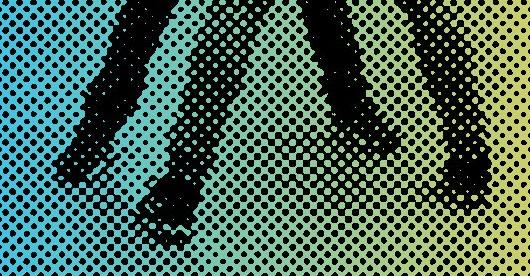
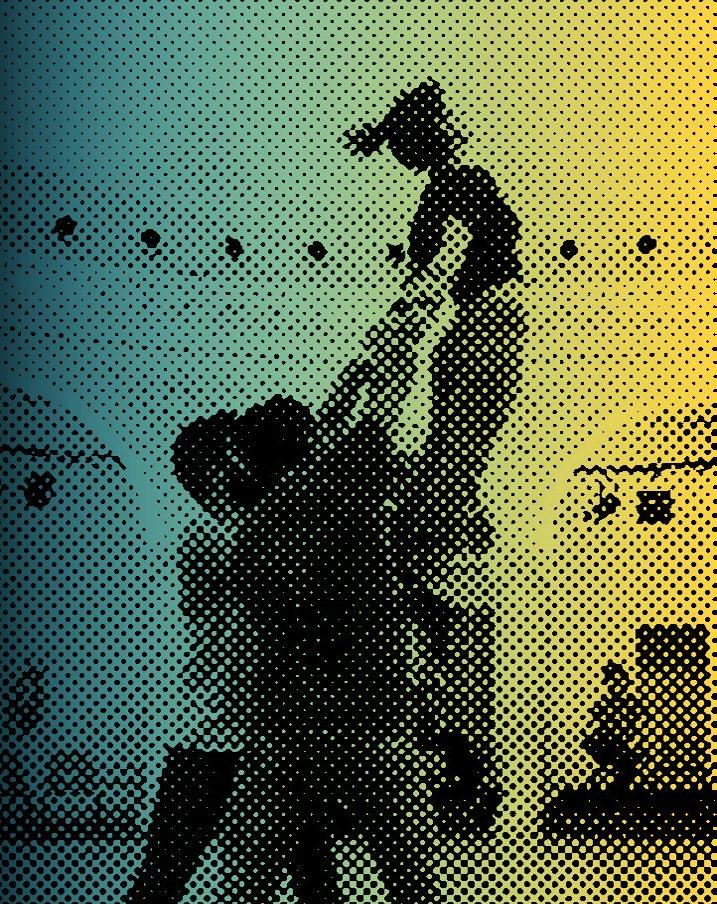
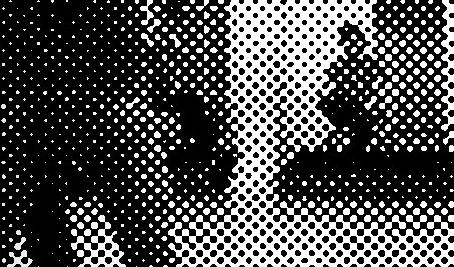
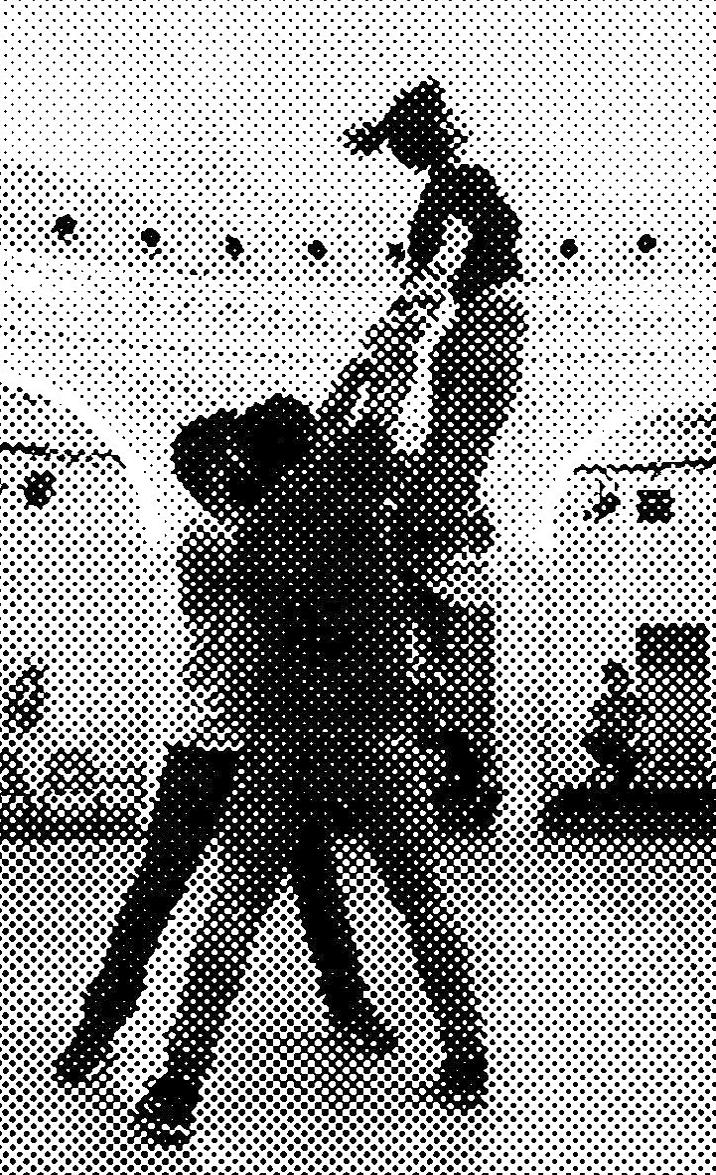
3A CUMBRE DE CULTURA DE CGLU BUENOS AIRES 3-5 DE ABRIL DE 2019 Las ciudades lideran las acciones sobre el rol de la cultura en el desarrollo sostenible

INTRODUCCIÓN
La 3ª Cumbre de Cultura de Ciudades y Gobiernos Locales Unidos tuvo lugar en Buenos Aires (República Argentina) del 3 al 5 de abril de 2019, con el auspicio del Gobierno de la Ciudad Autónoma de Buenos Aires. Tras las dos ediciones celebradas en Bilbao (2015) y Jeju (2017), la 3ª Cumbre de Cultura puso de manifiesto nuevamente que es en las ciudades donde se puede hacer realidad un modelo de desarrollo sostenible anclado fuertemente en la cultura. Ciudades de todo el mundo, representadas por sus gobiernos locales y por activistas y organizaciones de la sociedad civil, se reunieron en Buenos Aires para reafirmar su compromiso con el acceso y la participación en la vida cultural como derecho universal y con la cultura como marco interpretativo de las realidades contemporáneas.
La Cumbre de Cultura de CGLU es el principal punto de reunión internacional para las ciudades, los gobiernos locales y los agentes comprometidos con la implementación eficaz de políticas y programas sobre cultura y sostenibilidad. Las ricas y diversas experiencias que alberga la Ciudad de Buenos Aires en materia de paridad de género y derechos culturales, transformación social, jóvenes y cultura independiente, así como las numerosas experiencias de las ciudades y los actores participantes en la Cumbre, son testimonio de las infinitas posibilidades que las políticas culturales ancladas en memoria, derechos, diversidad, igualdad e innovación pueden ofrecer a las futuras generaciones en la construcción de un futuro sostenible.
El título de esta edición “Las ciudades lideran las acciones sobre el rol de la cultura en el desarrollo sostenible”, reivindicaba el papel indispensable de las ciudades y los territorios locales en el camino hacia el reconocimiento de la cultura como dimensión esencial del desarrollo sostenible. A lo largo de tres jornadas, las sesiones plenarias, talleres, visitas, presentaciones de proyectos y múltiples intercambios informales contribuyeron a visibilizar el vínculo entre cultura y desarrollo sostenible a escala local, favorecer el aprendizaje y la construcción de redes, y fortalecer la reflexión y el necesario debate en torno a estas cuestiones.
Las más de 500 personas asistentes a la Cumbre pudieron asimismo descubrir la riqueza de la vida cultural de Buenos Aires, de lo institucional a lo independiente, de los centros culturales más tradicionales a la vida en las calles. Los agentes
3

culturales de Buenos Aires tuvieron una importante presencia en el conjunto de las sesiones, junto a una representación amplia de gobiernos locales, artistas, organizaciones de la sociedad civil, académicos, organizaciones internacionales y otros agentes de todo el mundo.
En un contexto global marcado por conflictos crecientes que conllevan discursos de odio y fomentan confrontación, la 3ª Cumbre de Cultura de CGLU apuesta por facilitar la inclusión de voces diversas en el desarrollo de políticas, la construcción de políticas culturales basadas en el pleno respeto por los derechos humanos, y el fomento de la igualdad de género y la lucha contra las discriminaciones de todo tipo como ejes imprescindibles para las sociedades pacíficas en las que florece la creatividad desde la diversidad. Entender la cultura como cuarto pilar del desarrollo pone además a los jóvenes en el centro de las decisiones como actores de pleno derecho, agentes de cambio y transformación social. Nos aboca a la plena participación de las mujeres, y la definición de modelos de gobernanza y creación cultural que se basen en la colaboración entre esferas de gobierno y todos los demás actores, encontrando equilibrios y ejemplificándolo en la convivencia entre los programas institucionales, comerciales e independientes en la misma ciudad de Buenos Aires.
La Cumbre de Cultura se celebró por primera vez junto a la reunión del Buró Ejecutivo de CGLU, contando de esta forma con la participación de jefes de gobierno de numerosas ciudades y representantes de asociaciones de gobiernos locales y otras organizaciones de todo el mundo. Esta fórmula permitió confirmar que la reflexión sobre la cultura en las ciudades no está aislada, sino que se vincula al resto de retos a los que se enfrentan las ciudades. Esta transversalidad permite desarrollar políticas más eficaces.
El encuentro también sirvió para hacer un llamado a las Naciones Unidas, sus estados miembros y el resto de la comunidad internacional para reforzar la atención a la cultura en la Agenda 2030, los Objetivos de Desarrollo Sostenible (ODS), la Nueva Agenda Urbana y la Agenda de Cambio Climático. La transformación necesaria para alcanzar los ambiciosos objetivos comunes trazados no podrá conseguirse sin un anclaje fuerte en las comunidades con la cultura como herramienta de cohesión, transformación y esperanza.
Este documento presenta, a modo de testimonio y recuerdo, un resumen del conjunto de las sesiones de la 3ª Cumbre de Cultura de CGLU.
4


SESIÓN PARALELA D3. CULTURA Y TECNOLOGÍA: PIEZAS CLAVES EN EL ROMPECABEZAS DE LOS ESPACIOS CULTURALES INDEPENDIENTES
¿Cómo usan la tecnología los espacios culturales independientes para captar y desarrollar audiencias? El siglo XXI impone nuevas complejidades y oportunidades en el cruce entre ciencia, cultura y tecnología. En procesos culturales, la tecnología nos facilita infraestructura, mayor resonancia en la comunicación de contenidos y la posibilidad de unir espacios antes impensados. La sesión fue moderada por el editor Lalo Zanoni.
77
CUMBRE DE CULTURA DE CGLU BUENOS AIRES 3-5 DE ABRIL DE 2019

La primera intervención fue a cargo de Anita Massacane, curadora de Cultura Digital e Innovación en el Centro Cultural San Martín de la ciudad de Buenos Aires. La relación entre cultura e innovación es un eje estratégico de este Centro, un 25% de cuyo público asiste a actividades de cultura digital e innovación. El Centro Cultural San Martín quiere construir un espacio de cultura entendiendo que la dimensión digital es profundamente humana, nos atraviesa de manera inevitable y es necesario debatirla. Entre las actividades cabe destacar el festival anual #NoviembreElectrónico, punto de encuentro de agentes de todo tipo. De hecho, el trabajo en red y el cruce entre lo público y lo privado son algunas de las apuestas principales del Centro.
Por su parte, Gonzalo Solimano, Director del Festival Internacional de Creatividad Digital MUTEK Argentina, presentó esta iniciativa, parte de una plataforma global establecida hace 20 años y que se ha expandido a 7 países. Como reflejo del siglo XXI, MUTEK impulsa la música electrónica y la creatividad digital, contribuyendo a la generación de obras en procesos tecnológicos y colaborativos. La tecnología también es esencial en la comunicación del festival, pues este se dirige a una audiencia muy particular y, mediante la segmentación de audiencias y el marketing digital, también busca generar nuevos públicos vinculados a las distintas disciplinas del evento.
El fundador y coordinador general de la productora argentina Objeto a, Tomás Oulton, presentó esta organización, una pequeña productora cultural familiar especializada en el arte en nuevos medios. En sus más de 10 años de actividad, ha pasado de ser una galería a una productora, organizando más de 100 exposiciones
78
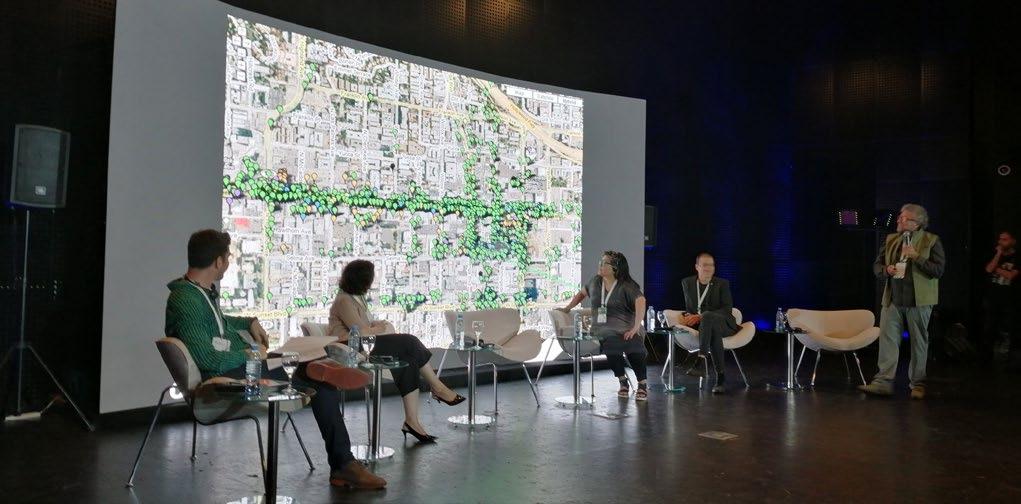

en su espacio y en otros, atrayendo a más de 120.000 personas. Entre sus proyectos se encuentran la Bienal Kosice, que incentiva el desarrollo de proyectos artísticotecnológicos; y Game On! El arte en juego, un evento con 10 años de recorrido que parte de la idea que los videojuegos son una disciplina artística.
ANA SERRANO ...
La Directora Digital del Media Lab del Centro Canadiense del Cine (CFC), Ana Serrano, expuso el objetivo del CFC de reunir el talento existente en Canadá en el campo audiovisual, remarcando la forma en que los medios (cine, TV, canales digitales) permiten a la población entender el rol de la tecnología en sus vidas. Además del desarrollo de públicos, que ha sido una prioridad desde el principio, la rendición de cuentas también es esencial. En un mundo en el que unas pocas plataformas digitales operan como monopolios, es necesario formar la próxima generación de creadores para poder operar fuera de este monopolio.
Por último, Fabián Wagmister, director fundador del Centro de Investigación en Ingeniería, Medios de Comunicación y Performance (REMAP) de la Universidad de California en Los Angeles (UCLA), presentó su vocación de investigar las formas en que la tecnología puede transmitir capacidad creativa a personas que antes no tenían la posibilidad de crear, generando así nuevos creadores y formas de creación colectiva. Reclamó la necesidad de un pensamiento crítico ante la tecnología, priorizando el interés colectivo y la creatividad comunitaria investigadora para diseñar mejores mundos.
En el debate final, a preguntas del moderador, se debatieron cuestiones como el potencial democratizador de la tecnología (destacando la democratización del storytelling y de algunas formas de arte contemporáneo, aunque también el hecho de que muchas obras siguen estando al alcance de una parte reducida de la población), los potenciales efectos perversos de buscar nuevas audiencias, y los riesgos que entrañan los eventos digitales en términos de producción y realización.
79
← BACK TO ALL EVENTS
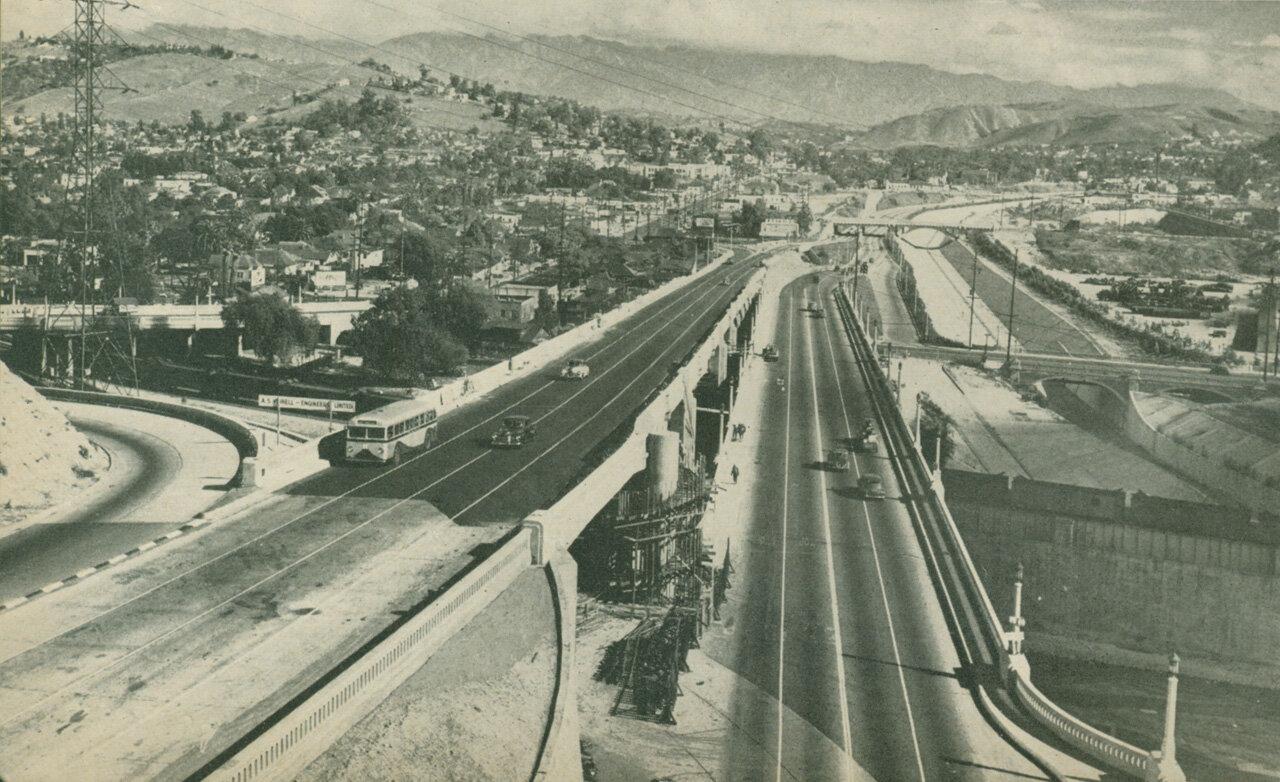
Railways, Waterways, and Walkways
Saturday, May 19, 2018 2:30 PM – 7 :30 PM
Glendale T ransportation Center 4 00 West Cerritos Avenue, Glendale, CA, 91204 , United States (map)
Google Calendar · ICS
A 6.5-mile walking explorat ion of some of Los Angeles’ best rail, st orm, and pedest rian infrast ruct ure — somet imes neglect ed, somet imes revit alized, always in flux. Several guest speakers will help us underst and t he past , present , and fut ure of t hese places:
Raf ael Escamilla, muralist /art ist — Trains Shaping History Noémie Despland-Lichtert & Brendan Shea, curat ors/designers/educat ors — Roundhouse Plat form Jenny Aleman-Zometa, environment al scient ist — LA River St at e Parks Part ners Tom Carroll, journalist /int erpret er — Tom Explores LA Fabian Wagmister, professor — UCLA REMAP Cheri G aulke, art ist /educat or — Woman’s Building Rosten Woo, art ist /designer/writ er/educat or — This Park Is Made by People
The walk will begin at t he G lendale Transport at ion Cent er and end at t he LA St at e Hist oric Park.
A collect ion of relat ed hist orical images can be found here: span.org/rww-phot os
This event was co-organized, in part, by Roundhouse Platform.
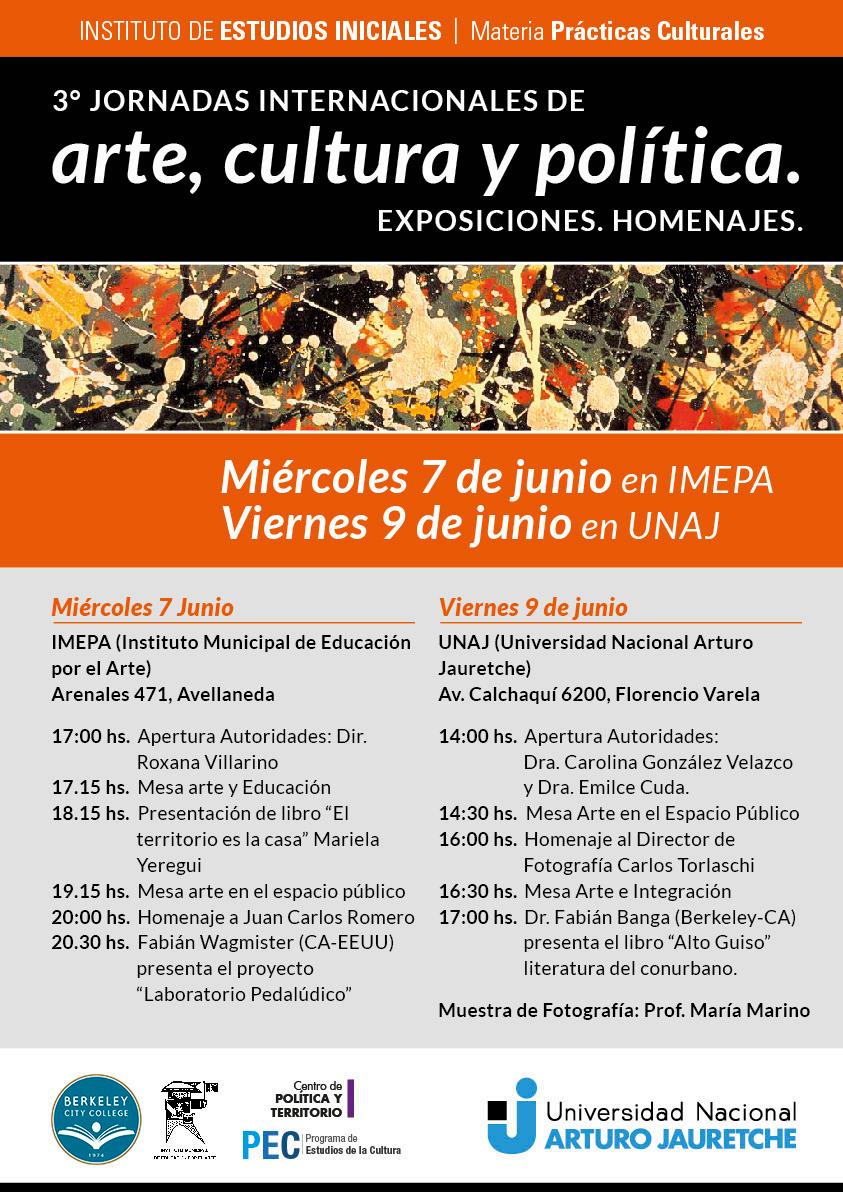
ATRÁS
FABIÁN WAGMISTER
JURADO MULTIDISCIPLINA / 2017
FORMADOR MULTIDISCIPLINA / 2017
Fabian Wagmister es profesor de creatividad audiovisual y medios interactivos en el Departamento de Cine, Televisión y Medios Digitales de la Universidad de California, Los Angeles (UCLA) donde dirige el Centro de Investigación en Ingeniería, Medios y Performance (REMAP). Como parte de REMAP ha creado y también dirige del Laboratorio de Medio Interpretativos (IMLab), una colaboración con de Departamento Californiano de Parques Estatales para el desarrollo e implementación de sistemas de interpretación participativa para espacios públicos.
La obra de Fabian Wagmister se centra en sistemas tecnoculturales de creatividad colectiva que promuevan el compromiso cívico y fortalezcan la identidad comunitaria. Colabora con diversas comunidades para generar sistemas interactivos anclados en la especicidad cultural local. En este contexto, la tecnología y la cultura convergen en una práctica social performatica que entrelaza la investigación y la expresión colectiva en espacio público.
Nacido en La Pampa, Argentina, Fabian colabora activamente con artistas y pensadores de toda América Latina. En Buenos Aires, Argentina, creó y dirige el Centro Hipermediático Experimental Latinoamericano (cheLA), un proyecto dedicado a la investigación y experimentación en las intersecciones de comunidad, cultura y tecnología. cheLA ofrece un entorno físico, tecnológico, y social para el desarrollo de proyectos culturales multidisciplinarios que involucren colaboración entre artistas, trabajadores sociales, tecnólogos y la comunidad.
Proyectos creados por Fabian Wagmister incluyen incluyen la aplicación móvil de realidad aumentada Skyline Traces (2012), la instalación interactiva Memoria Barrial (2012), la intervención barrial Navilandia Al Sur (2012), el sitio web móvil LASHP Trails (2014) el pasado, el presente y el futuro de Los Ángeles, y el ambiente inmersivo experimental Experiencia Ibera (2016) sobre las riquezas naturales de uno de los humedales más grandes del mundo.
En los últimos seis años, Fabian Wagmister adopto la bicicleta como eje central de su vida personal y profesional y su acción comunitaria. Para Wagmister la movilidad autónoma impulsada por la propia energía permite recuperar el control del espacio y el tiempo, promueve mayor compromiso con el aquí y ahora, y tiene implicaciones transformadoras a nivel personal y colectivo.
Actualmente se encuentra totalmente abocado al desarrollo de PedaLúdico, un conjunto de actividades promoviendo el dialogo, la reexión y el desarrollo de proyectos artisticos en relación a la bici-cultura. Como parte de este proyecto dirigirá la residencia Laboratorio PedaLúdico para la Bienal Arte Joven Buenos Aires.
TOP
COMUNIDAD
¿QUÉ ES? CONVOCATORIAS PRODUCCIONES CAMPUS RESIDENCIAS PROGRAMACIÓN COMUNIDAD BLOG CONTACTO PRENSA MÁS COMUNIDAD BIENAL
MARÍA EMILIA FRANCHIGNONI
SANTIAGO VÁZQUEZ
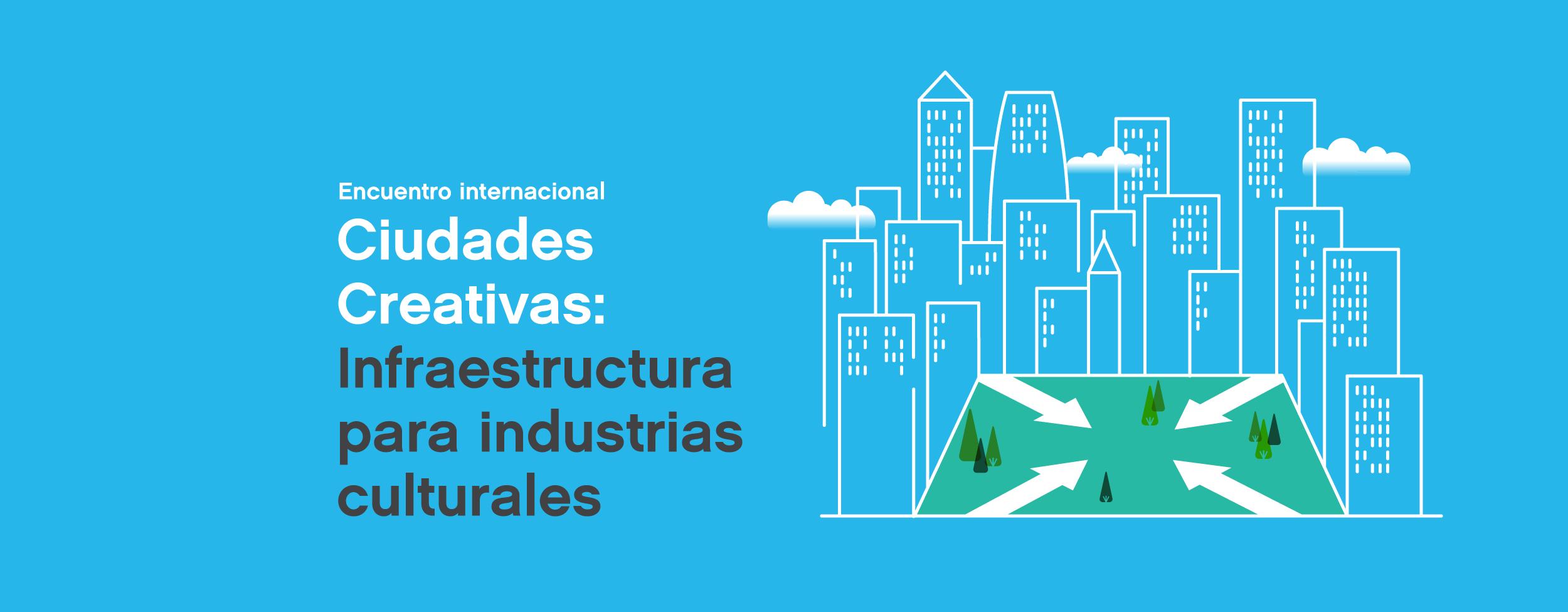
Nuev a infraestructura para las ciudadanías creativ as
Ciudades Creativas Follow Nov 16, 2016 · 5 min read
Sea b ajo l a f o rma de c luste r audi o vi sual , po l o t ec n o lógi c o , c ampus urb an o o fáb ri c a rec o n ver t i da en mul t i espac i o para l a ex peri men t ac ión , un n uevo mo do de pen sar l a i n f raest ruc t ura urb an a po t en c i a a l as i n dust ri as c reat i vas y redef i n e a l as c i udades.
La e co n o mía cr e ativa e s e min e n te me n te ur b an a y r e q uie r e de su pr o pia in fr ae str uctur a. Cada ciudad e s un e n to r n o ún ico , co n sus pr o pias n e ce sidade s. En lo s último s año s var ias e xpe r ie n cias mue str an cómo la n ue va in fr ae str uctur a ur b an a pue de aco mpañar la pr o life r ación de las in dustr ias cr e ativas. De e llo se hab ló e n e l se gun do pan e l de l e n cue n tr o in te r n acio n al Ciudade s Cr e ativas.
El cin e asta J uan Pab lo Astié, vice pr e side n te de la aso ciación Film An de s, co n tó lo s paso s q ue e stá dan do e sta aso ciación civil par a cr e ar un cluste r audio visual e n la ciudad de Me n do za. Astié hizo ade más de e n lace co n
o tr o s caso s, q ue pr e se n tar o n J ulio Ace ve do , pr e side n te de l fide ico miso Ciudad Cr e ativa Digital Guadalajar a; Uwe Br an de s, dir e cto r de l pr o gr ama de plan e amie n to ur b an o y r e gio n al de la Un ive r sidad de Ge o r ge to wn , y Fab ián Wagmiste r, pr o fe so r de la Un ive r sidad de Califo r n ia, Lo s Án ge le s (UCL A) e impulso r de l Ce n tr o Hipe r me diático Expe r ime n tal Latin o ame r ican o (che L A), e n Bue n o s Air e s.
“Ciudad Cr e ativa Digital (CCD) e s un plan fe de r al cuyo o b je tivo e s de sar r o llar un po lo glo b al de pr o ducción audio visual digital y te cn o lógica, de n tr o de un pr o to tipo de ciudad in te lige n te ”, e xplicó Ace ve do . Co n e l fo r mato de fide ico miso , CCD se pr o po n e co mo un a gr an o b r a de de sar r o llo in dustr ial, ur b an o y so cial q ue hace fo co e n la
CCD trabajó con cinco organizaciones lideradas por el Massachusetts Institute of Technology (MIT) para definir un plan maestro, para el que además recibió apoyo del gobierno mexicano. “Un elemento fundamental fue la cultura de emprendimiento, innovación y disciplina de la ciudad. Somos el Silicon Valley de México. Contamos con el 40% de la industria tecnológica del país, el 55% del total de las exportaciones de Jalisco, y 650 empresas y 40 centros de diseño de alta tecnología nos han elegido para establecerse” , describió Acevedo. En este contexto, la industria tecnológica emplea a más de 120.000 personas en una ciudad de casi 5 millones de habitantes. El proyecto CCD planea que esos puestos de trabajo se multipliquen a medida que crezca la infraestructura.
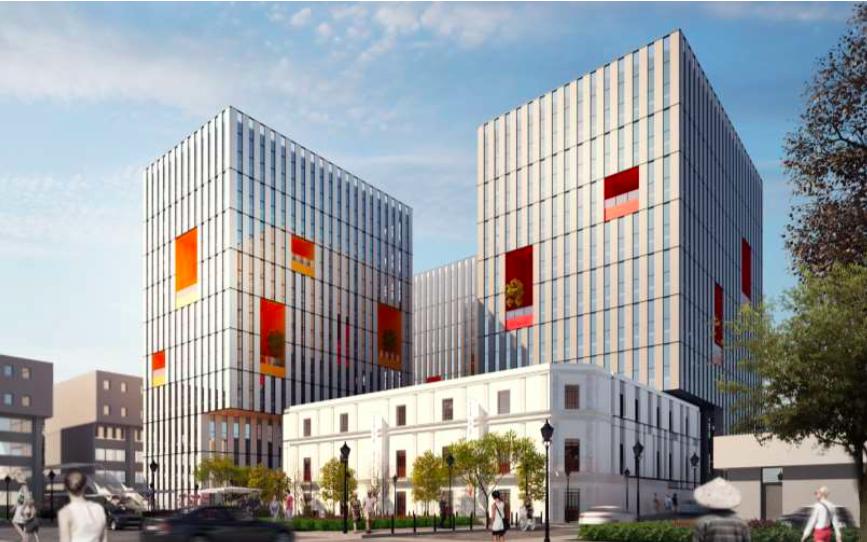
El proyecto CCD se propone revitalizar una zona postergada del centro de Guadalajara. Foto:
“La superficie total del emprendimiento alcanza las 42 hectáreas en un área de la ciudad que lleva décadas postergada. Nuestro objetivo primario es el desarrollo de un polo global de industria que genere 1500 puestos de trabajo en la etapa inicial y ponga el polo a funcionar. En 10 años, el MIT estima que los empleos del sector creativo llegarán a 20.000, y que CCD representará el 15% de la producción nacional audiovisual digital” , cerró Acevedo.
Uwe Brandes, académico de la Universidad de Georgetown, sumó otro enfoque al debate. Para Brandes, académico de la Universidad de Georgetown, no estamos acostumbrados a pensar novedosamente en la infraestructura. Por ejemplo, varias ciudades estadounidenses han revitalizado sus centros mediante la inversión en infraestructura

educativa. Más en concreto, en universidades. Un caso es el de Phoenix, Arizona, una ciudad que según Brandes los urbanistas “aman odiar” .
Un tranvía conecta los diferentes edificios de la universidad y sirve como enlace entre los barrios de Phoenix.
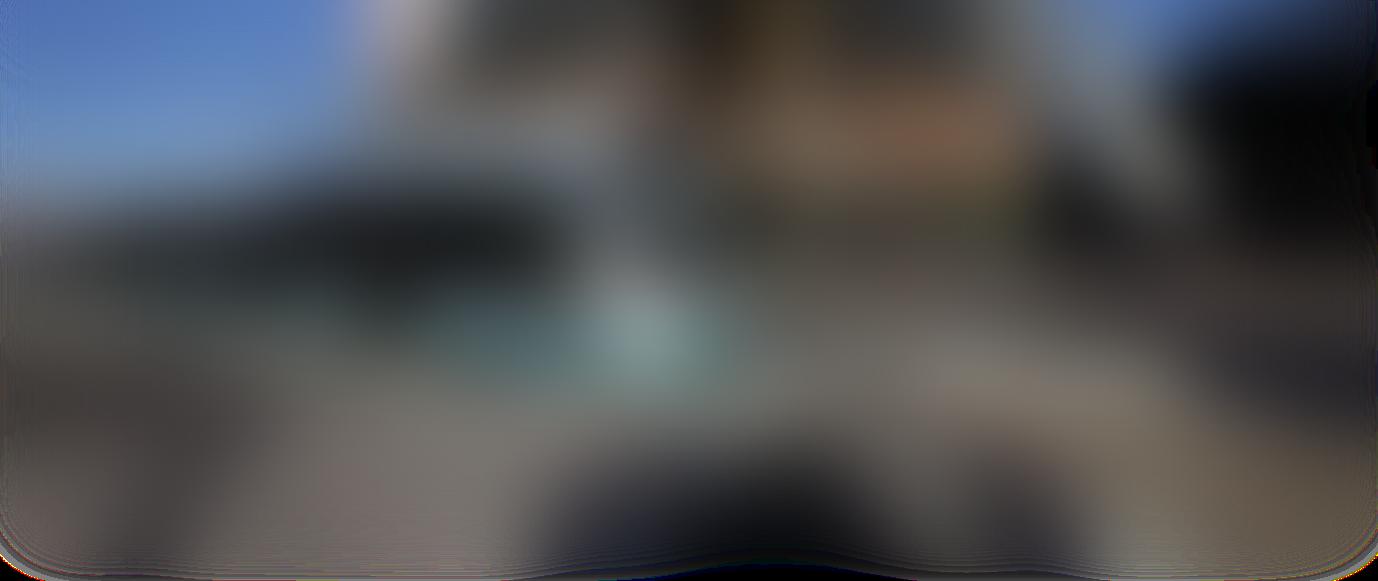
“No hay razón para que haya una ciudad donde falta el agua, donde hace tanto calor” , dijo Brandes. Pero dado que la ciudad ya existe, el visionario rector de la universidad tomó como propia la responsabilidad de revitalizar el centro de la ciudad, y usó la infraestructura educativa como el motor que puso en marcha a su vez a la infraestructura tradicional. Hoy, el tranvía que conecta los diferentes edificios de la Arizona State University es, además de un medio de transporte, el aglutinador de la ciudad, que la integra y la hace una, mucho más que un conjunto de zonas aisladas entre sí. Arizona State University es además un dínamo urbano: la universidad pública más grande de Estados Unidos, tiene 81.000 estudiantes, 66.000 empleados y genera un impacto económico de 4000 millones de dólares.
Entre los rascacielos del centro financiero de Chicago, el campus urbano concentra 22 universidades.

Chicago fue el segundo ejemplo que Brandes trajo al auditorio de la UADE. Conocida como una de las ciudades donde nacieron los
rascacielos, hoy en su centro financiero y de negocios también ha encontrado espacio para el America ´ s Urban Campus, donde conviven 58.000 estudiantes y 22 universidades. Esta ciudad dentro de la ciudad genera 46.000 puestos de trabajo y un impacto en la economía que alcanza los 12.000 millones de dólares.
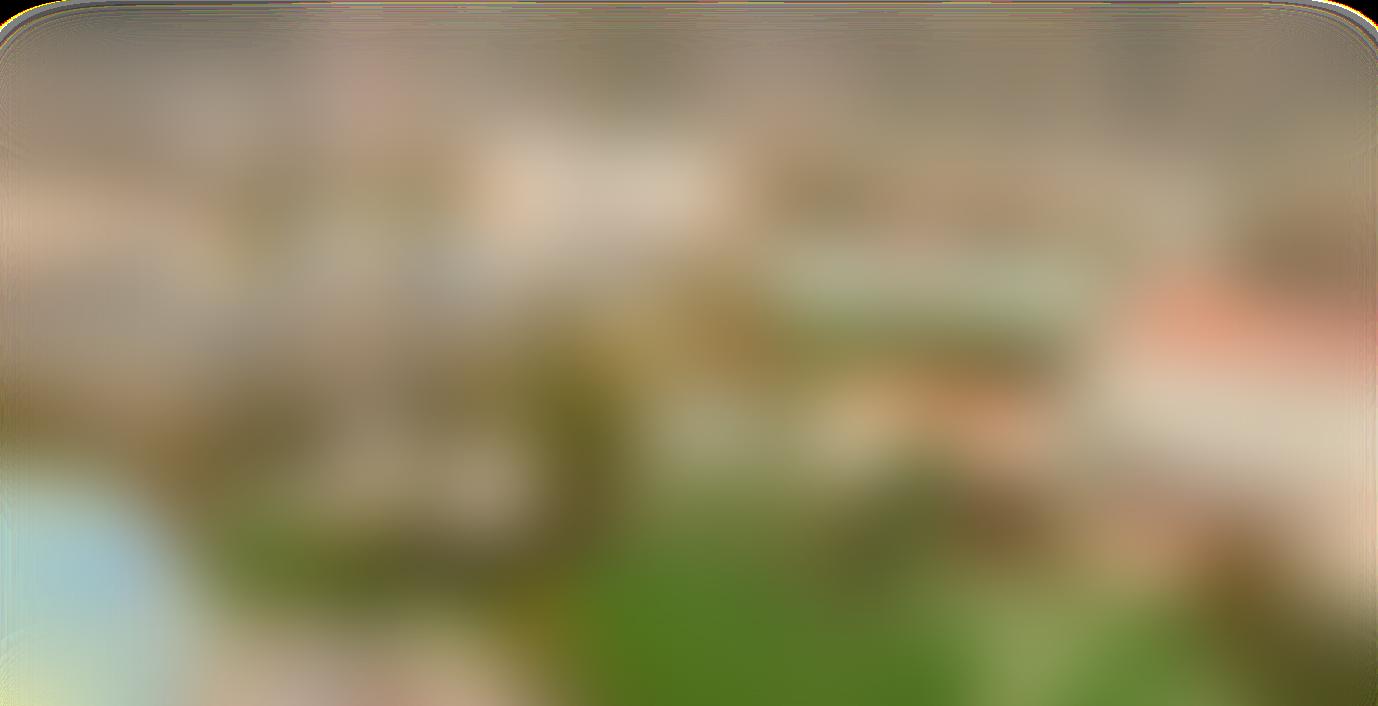
Las universidades de Washington trabajan de manera coordinada para atraer talentos y generar proyectos.

Por último, Brandes contó cómo funciona el consorcio de universidades de Washington que, desde hace veinte años, trabaja junto a la comunidad para mejorar la ciudad a través de la planificación. El consorcio está compuesto por 16 universidades y 250.000 estudiantes, que generan 10.000 millones de dólares de impacto económico. Pero además, el consorcio enriquece el perfil de la ciudad, la vuelve más múltiple, diversa y productiva. Transformarse en un centro universitario le permite a Washington atraer talento y producir nuevos cruces, como el de la incubadora y aceleradora 1776, que se concentra en emprendimientos tecnológicos aplicados a las industrias de servicios públicos.
Fabián Wagmister aportó al panel su doble experiencia como profesor de UCLA y director del cheLA. El centro hipermediático que fundó es un ejemplo de cómo la vieja infraestructura puede reconvertirse para nuevos usos y contribuir a revitalizar zonas urbanas. El cheLA funciona en una ex fábrica de insumos de amianto de Parque Patricios, y aprovecha el espacio generoso de la arquitectura industrial para proyectos creativos que también hacen uso intensivo del espacio, como performances o el prototipado de mobiliario urbano, algo que no podría hacerse en el centro de la ciudad. Pero, además, Wagmister mostró trabajos de alumnos del Departamento de Cine, Televisión y Medios Digitales de UCLA como ejemplos de creatividad aplicada, que parten de los propios ciudadanos para impactar en el espacio urbano y crear comunidad.
Los alumnos de UCLA colaboran con los proyectos urbanísticos de la ciudad. Foto: gentileza Fabián Wagmister.

“No creo que las ciudades sean creativas. Las creativas son las ciudadanías — dijo Wagmister — . La creatividad reside en la gente, en las comunidades. Y su importancia no solo es el beneficio económico, sino también que alimenta la formación de la identidad colectiva. Más importante que el producto creativo es la importancia de la creatividad para la comunidad” , completó.
WRITTEN BY Ciudades Creativas
Ciudades Creativas
El Medium del encuentro internacional Ciudades Creativas
Follow
Follow
Learn more.
Medium is an open platform where 170 million readers come to find insightful and dynamic thinking. Here, expert and undiscovered voices alike dive into the heart of any topic and bring new ideas to the surface. Learn more Make Medium yours.
Follow the writers, publications, and topics that matter to you, and you’ll see them on your homepage and in your inbox. Explore Write a story on Medium.
If you have a story to tell, knowledge to share, or a perspective to offer — welcome home. It’s easy and free to post your thinking on any topic. Start a blog
About Write Help Legal


BIENES RAÍCES Y ARQUITECTURA MATERIALES Y DECO INDICADORES Y FINANZAS ACTUALIDAD Y DATA OBRAS PÚBLICAS TV ÁREAS
AGENDA
Portada / Actualidad y Data / Nota
27.10.16
Impacto económico de cultura e innovación
La innovación es la matriz del crecimiento de las ciudades, y generadora de impacto económico positivo. Varios especialistas lo dejaron en claro durante un encuentro.
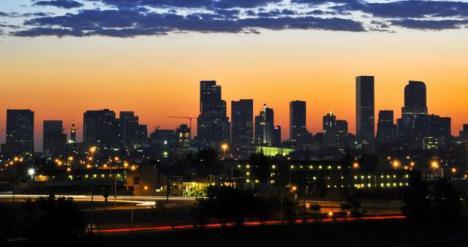
Ciudad de Phoenix
Fue durante el desarrollo de Ciudades Creativas, organizado por el BID, junto con el Ministerio de Cultura y la UADE. Juan Pablo Astié, moderador del panel sobre La nueva infraestructura de ciudades creativas, habló del proyecto que dinamiza, a partir de la antigua Film Andes, creada por bodegueros en los años 40’: un polo audiovisual destinado al desarrollo de proyectos de producción cinematográfica y televisiva, además de publicidad para Latinoamérica y el mundo. La idea es instalar siete unidades productivas, en Godoy Cruz, en la provincia de Mendoza, en un Parque empresarial de casi 6 hectáreas, que cobije cine, capacitación, stage tv, museo audivisual, y el futuro impulso a un festival de cine. Un desarrollo a imagen del centro de artes internacional Tabakalera, de San Sebastian en España.
Por su parte Julio Acevedo, ex empresario y presidente de la Ciudad creativa digital de Guadalajara, proyecto federal que tiene como objetivo renovar un entorno urbano con el desarrollo de un polo global de producción tecnológica, describió la propuesta cuya primera parte se inaugura a próximamente con una torre y estacionamientos. Sobre un predio de 43 hectáreas, con el asesoramiento del MIT, se arma un proyecto que repoblaría un área deprimida, de uso mixto. Representa una inversión de US$ 5.100 millones, y generará 18.000 puestos de trabajo; Incluirá vivienda, educación, un parque de 5 hectáreas, un museo, y una universidad digital.
Uwe Brandes, director del Programa de Planificación de la Universidad de Georgetown, refirió que la nueva infraestructura es disruptiva, y ejemplificó con casos de tres ciudades norteamericanas. Una es Phoenix, que “perdía base y reazón de ser” y donde un rector de la universidad local está ayudando a través de pequeñas organizaciones distribuidas a lo largo de la ciudad, a revitalizarla. En este caso el impacto económico como efecto potencial se calcula en billones de dólares. El segundo ejemplo es Chicago, cuyo campus urbano universitario distribuido en 22 institutos diferentes de aprendizaje, ya generó 46.000 puestos de trabajo, y el interés de 58.000 alumnos. Finalmente Washington, tradicionalmente asociada con el Gobierno, que puso en marcha una diversificación económica, a través de un convenio con 1776 Inc., una incubadora que ayuda a pequeños emprendedores en materia de energía y sustentabilidad, salud, educación y transporte. Ellos llevaron adelante Union Market, una gran cocina para todos los food trucks al lado de la universidad y un centro digital dentro de la biblioteca pública, la remodelación de antiguos espacios ahora abiertos al público e instituciones creativas, que multiplicaron el impacto económico.
RANKING: Las más leídas

1 Un horizonte estable para sostener inversiones
2 El usuario final se impuso como protagonista en 2021
3 Los emprendimientos suburbanos corren con ventajas
4 Aprobó la Legislatura promover el área céntrica de la ciudad
5 Cambios de tendencias en el alquiler de oficinas y locales
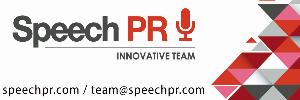
OPINIÓN DE LOS EXPERTOS
Un horizonte estable para sostener inversiones
Con la inversión en obras públicas que se estima creciente, Gustavo Weiss, presidente de la Cámara Argentina de la Construcción se mostró optimista ante el balance del año. Aunque el nivel del empleo aún está por debajo del período 2015/17.
Newsletter
Suscríbete sin cargo y recibe las novedades en tu e-mail.
AGENDA +
DIC 20
Diplomatura en Desarrollo Inmobiliario Urbano
DIC 17
Experimentación con la luz
DIC 16
DIC 15
DIC 06
Vivir el agua
TENDIEZ Experiencias: Espacios para la cultura y la gastronomía
Cambio climático
aspecto, expuso sobre el Parque Histórico de Los Angeles, que se inaugurará en enero próximo, del que participó la comunidad a través de un mural interactivo, a la vez que se lamentó de “la poca calidad de la creatividad en la educación argentina”. La verdadera infraestructura en las ciudades tiene que ser social y no tecnológica, dijo, y que en este contexto el rol del Estado es el de blindar los proyectos para que sigan en el largo plazo.

SECCIONES
Bienes Raíces y Arquitectura Materiales y Deco Indicadores y Finanzas Actualidad y Data Obras Públicas TV ÁREAS Agenda Newsletter Quiénes Somos La Revista
CONTÁCTENOS
Teléfono: (011) 4777-8220 Celular: (011) 15 40 73 64 88 Contáctenos: info@areas-digital.com.ar
» Suscríbete a la revista RSS
Áreas Digital Bienes Raíces y Arquitectura Materiales y Deco Indicadores y Finanzas Actualidad y Data Obras Públicas Agenda
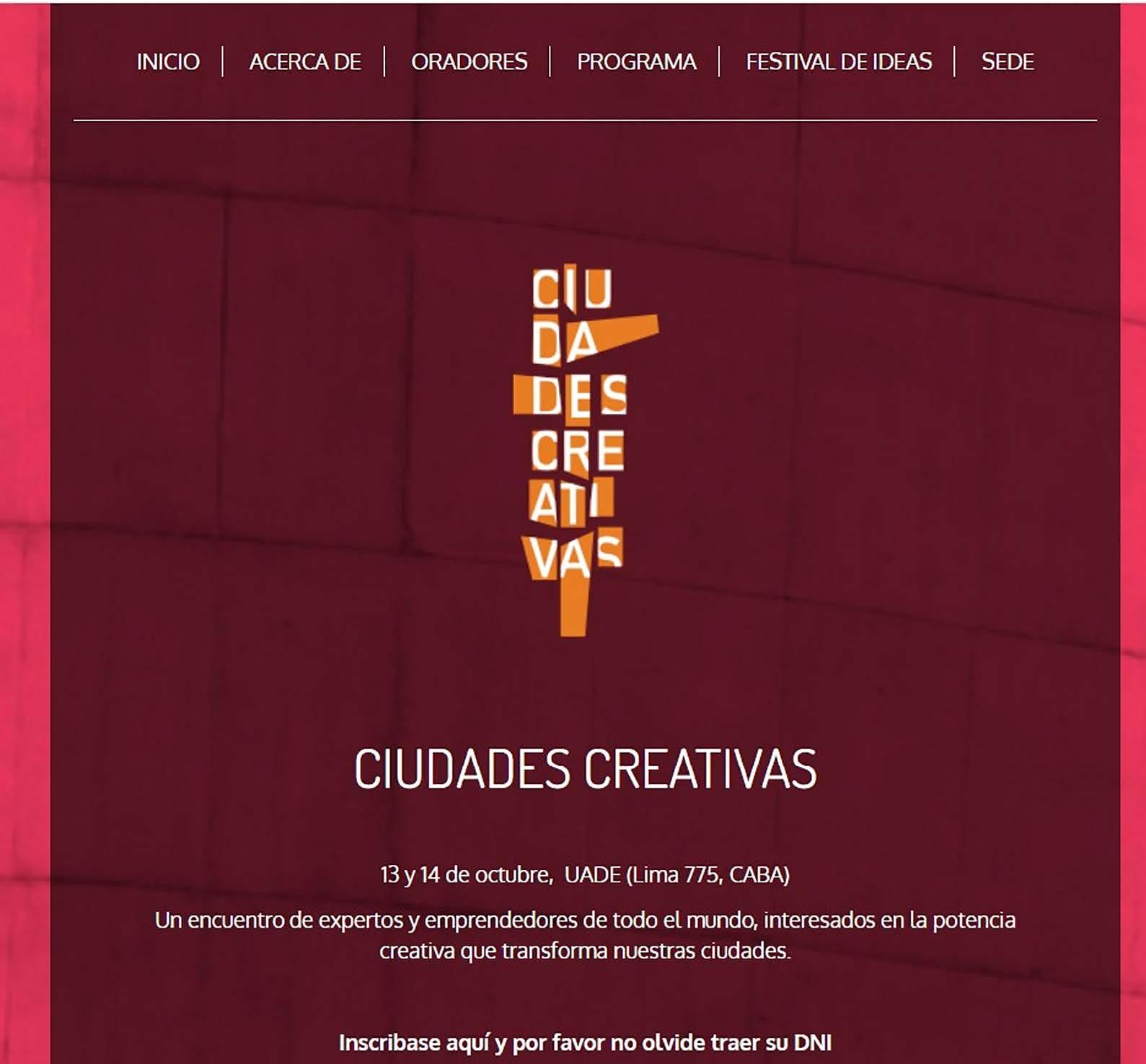
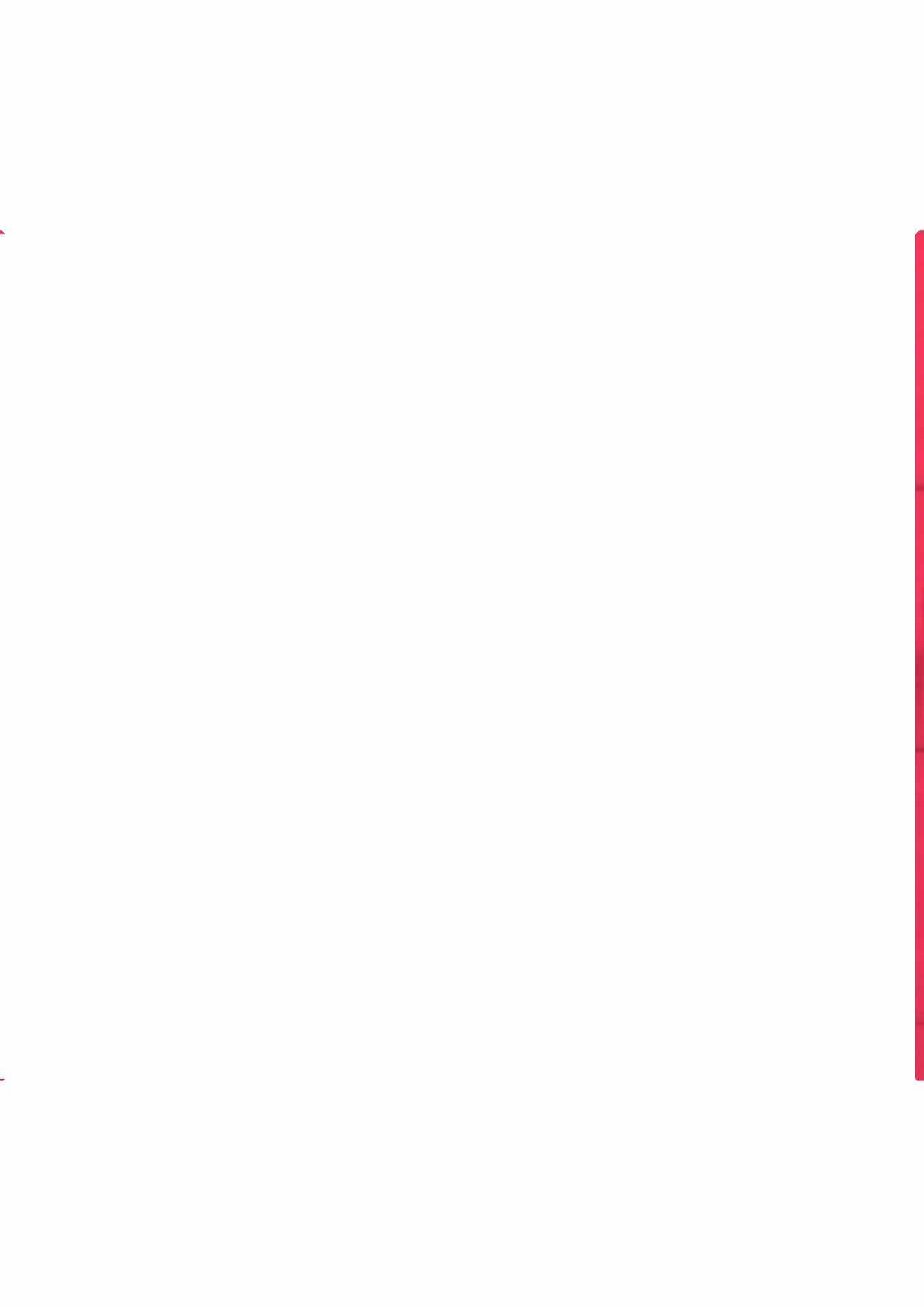
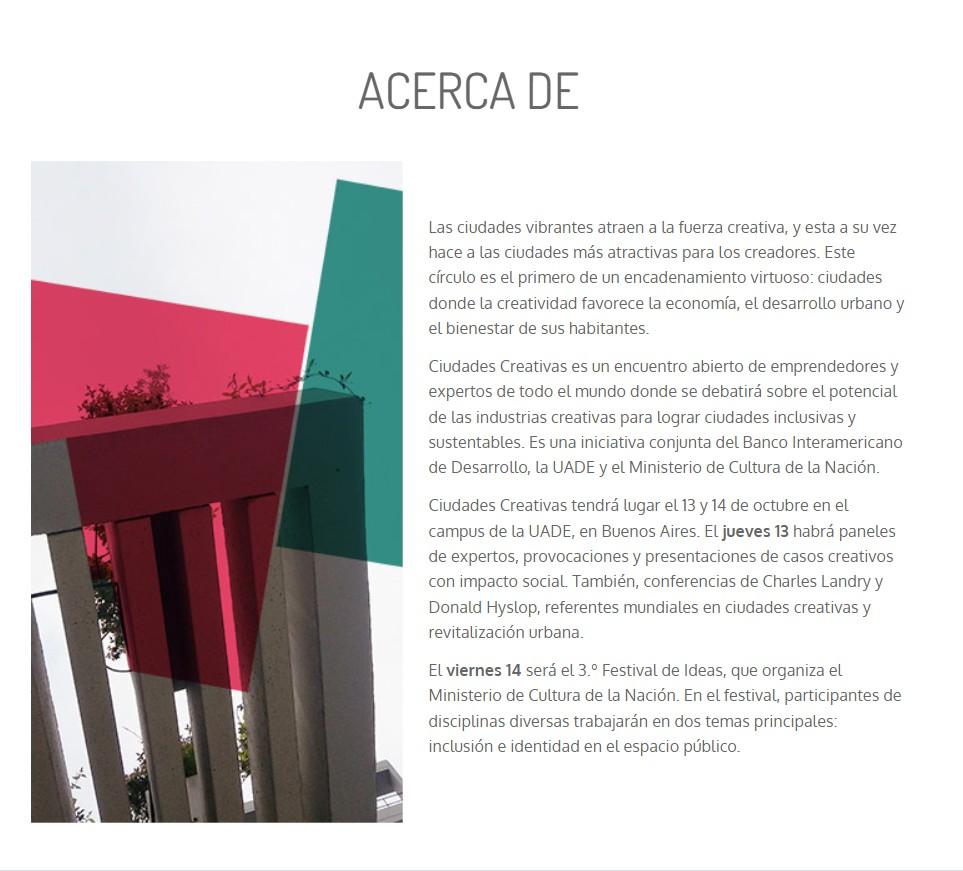
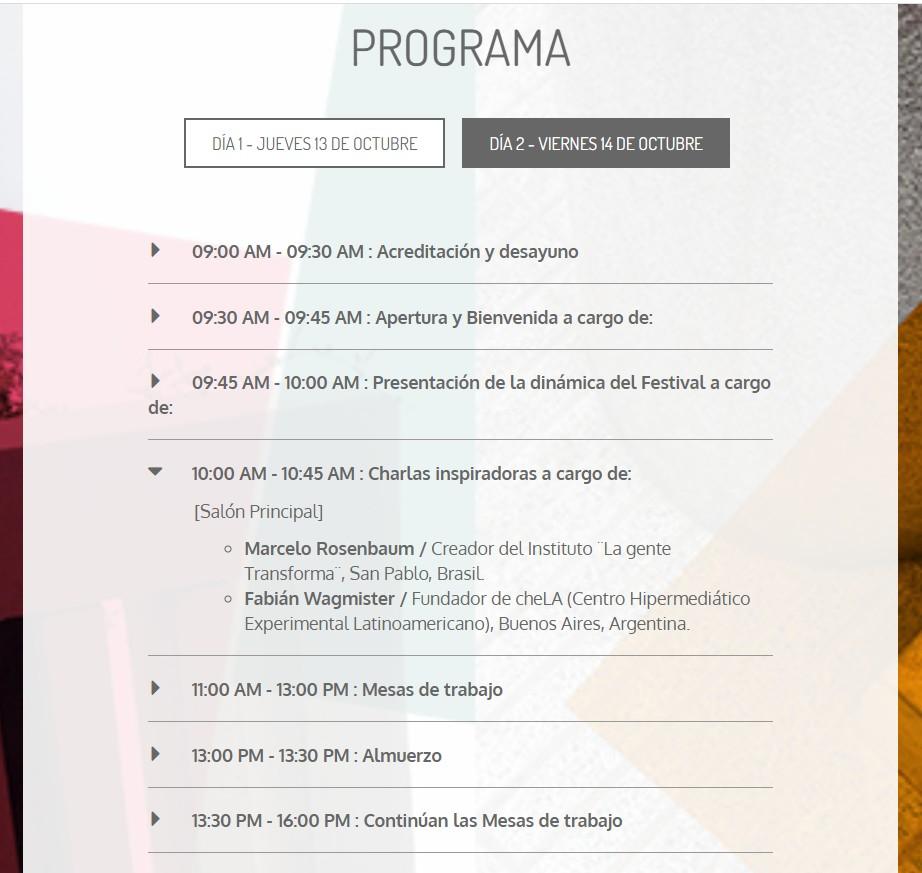
C I U D A D E S C R E AT I VA S
Buenos Aires, ARG 13 y 14 de Octubre de 2016
El Banco Interamericano de Desarrollo, a través del Programa de Ciudades Emergentes y Sostenibles (CES), el Ministerio de Cultura de la Nación Argentina, a través de la Subsecretaría de Economía Creativa y la Fundación UADE (Universidad Argentina de la Empresa), a través de la Facultad de Arquitectura y Diseño, se complacen en invitarlo al encuentro “Ciudades Creativas” que se llevará a cabo el 13 y 14 de Octubre de 2016 en las instalaciones de la UADE en Ciudad de Buenos Aires, Argentina. Este encuentro internacional se centrará en la articulación de la economía creativa con el desarrollo de ciudades inclusivas y sustentables, para contribuir con el debate sobre el planeamiento urbano y las industrias culturales. El encuentro se estructurará en dos días. El primero será una jornada dinámica de presentaciones inspiradoras, debates y pitches creativos. El segundo día incluirá workshops de expertos y un “festival de ideas” para emprendedores culturales.
Debido a su perfil y expertise, consideramos que su presencia es fundamental en la discusión sobre el desarrollo e impacto de las industrias creativas en las ciudades de América Latina. Por esto es que nos complace invitarlo a formar parte de la jornada de debates a desarrollar el primer día del evento. En caso de contar con su interés, nos contactaremos individualmente para avanzar con detalles de su financiamiento.
Esperamos contar con su destacada presencia, y sin otro particular lo saluda atentamente,
El comité organizador

I ndustrias creativ as y urbanismo confluy en el 13 de octubre
Ciudades Creativas Follow Oct 11, 2016 · 3 min read
Ciudades Creativas reunirá a urbanistas, académicos, agitadores culturales y emprendedores para debatir y compartir experiencias sobre el cruce entre las industrias creativas y la planificación urbana.
El 13 de octubre todos los caminos del urbanismo y las industrias creativas conducen al campus de la UADE. El encuentro internacional Ciudades Creativas, con inscripción gratuita, será una jornada de intercambio, inspiración y provocaciones.
Kreatópolis y mentefacturas pueden parecer palabras en clave, pero aspiran a nombrar una tendencia cada vez más central en nuestras vidas: la de ciudades cuyo motor económico pasa de la producción industrial a la producción intelectual, ciudades que fomentan la creatividad como política de desarrollo. El secretario de Cultura y Creatividad de la Nación, Enrique Avogadro, coordinará una charla con el mexicano Ernesto Piedras (CEO de The Competitive Intelligence Unit) y el brasileño Marcelo Rosembaum (CEO del instituto A Gente Transforma). La charla planteará los desafíos y oportunidades que enfrentan las ciudades latinoamericanas para plasmar esta tendencia.
Las ciudades creativas requieren su propia infraestructura. Sobre ello hablarán Fabián Wagmister (director del Centro Hipermediático Experimental Latinoamericano), Julio Acevedo (presidente del fideicomiso Ciudad Creativa Digital Guadalajara) y Uwe Brandes (director del Programa de Planificación Urbana de la Universidad de Georgetown, Estados Unidos), en una charla moderada por el cineasta Juan Pablo Astie.
Algunas ciudades ya tienen un camino recorrido en cuanto a planificación urbana para favorecer la economía creativa. Bilbao, Buenos Aires, Ciudad de México y Manizales compartirán sus experiencias. En una charla moderada por Mora Scillamá (directora nacional de Industrias Creativas), Isaac Serrano (director del área Geografía Urbana del Laboratorio para la Ciudad de México), Andy Freire (ministro de Modernización, Innovación y Tecnología de la Ciudad de Buenos Aires), Alfonso Martínez Cearra (director del proyecto de revitalización Bilbao Metrópoli-30) y Felipe César Londoño (rector de la Universidad de Caldas) contarán cómo acompañan sus ciudades a las industrias creativas.
Los mundos de las finanzas, el arte, el periodismo, la innovación y la academia estarán representados en un panel moderado por Roberto Converti, decano de la Facultad de Arquitectura y Urbanismo de la UADE. Germán Rey (director del Centro Ático de Tecnologías de la Universidad Javeriana de Bogotá), Tino Lutteral (Distrito Tigre Sur), Facundo Gómez Minujín (director de ArteBA y vicepresidente del Fondo Nacional de las Artes) y Miguel Jurado (codirector de la revista Clarín Arquitectura) debatirán cómo repensar la planificación urbana.
En el encuentro Ciudades Creativas también habrá lugar para presentaciones breves, de cinco minutos, de experiencias innovadoras e inspiradoras. Experiencias basadas en disciplinas tan disímiles como el diseño industrial, las artes circenses o la robótica, pero con un punto común: el giro innovador, la aplicación de la creatividad, la inquietud emprendedora, que genera actividad y motoriza a las ciudades.
La inspiración también llegará de dos conferencias a cargo de especialistas internacionales de renombre. El urbanista británico e inventor del concepto de ciudades creativas, Charles Landr y, participará del encuentro con una exposición sobre revitalización urbana. Donald Hyslop, referente mundial en proyectos de renovación y responsable de la puesta en valor del área sur de Londres (Bankside), compartirá detalles de su trabajo al frente de la unidad de Regeneración y Asociaciones con la Comunidad de la Tate Modern Galler y.
Las actividades continuarán el viernes 14 en el 3º Festival de Ideas, que organiza el Ministerio de Cultura de la Nación. Allí, participantes seleccionados por el ministerio trabajarán en dos temas principales: inclusión e identidad en el espacio público.
El 13 de octubre todos los caminos del urbanismo y las industrias creativas conducen al campus de la UADE. Caminos que transitarán profesionales de disciplinas variadas, cada quien con una experiencia o una idea para compartir. Caminos que puede emprender quien quiera, abiertos a todos los que vean en la fuerza creativa un motor para el desarrollo de las ciudades.
Urbanismo Innovación Emprendedores Sostenibilidad Creatividad
2
W R I T T E N B Y Ciudades Creativas
Learn more.
Medium is an open platform where 170 million readers come to find insightful and dynamic thinking. Here, expert and undiscovered voices alike dive into the heart of any topic andbring new ideas to the surface. Learn more Make Medium yours.
Follow the writers, publications, and topics that matter to you,and you’ll see them on your homepage and in your inbox. Explore Follow
Write a story on Medium.
If you have a story to tell, knowledge to share, or a perspective to offer — welcome home. It’s easy and free topost your thinking on any topic. Start a blog
About Write Help Legal
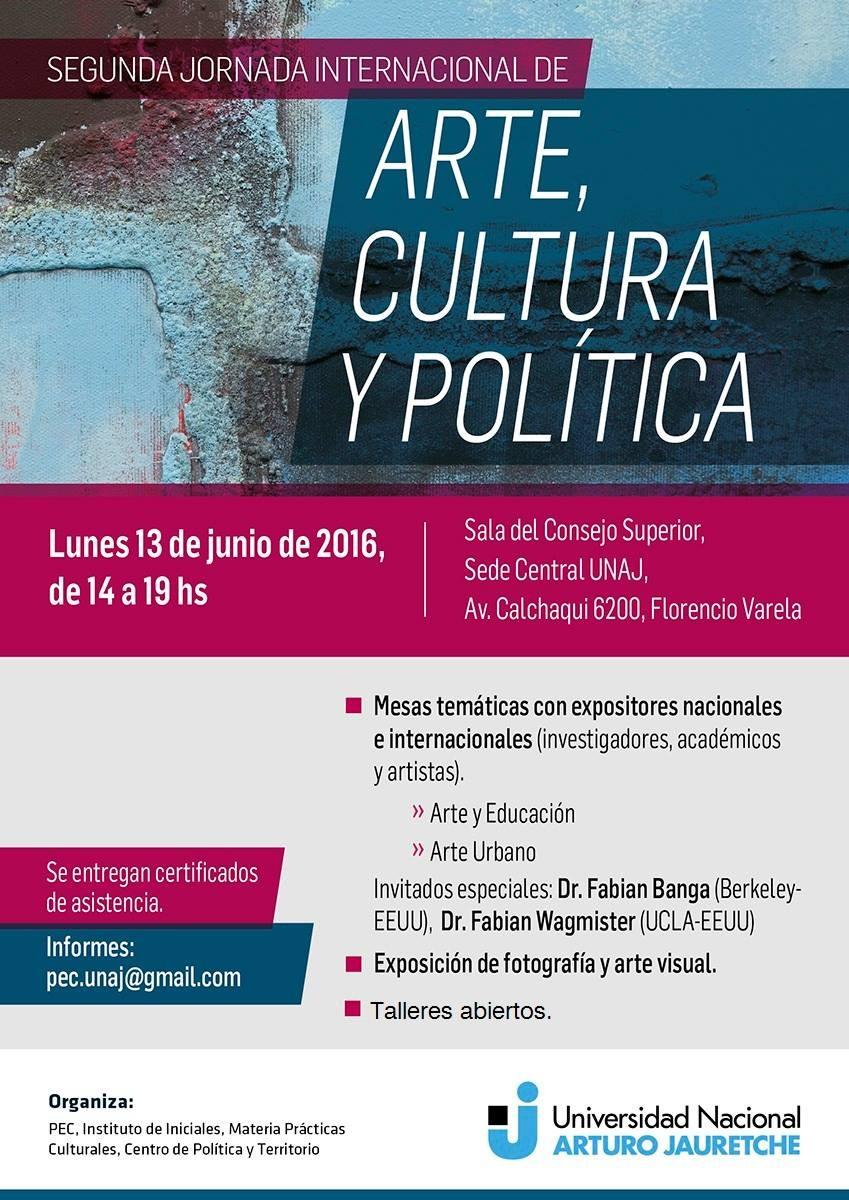
Dejamos constancia que el Prof. Fabian Wagmister participó como PANELISTA en la Segunda Jornada Internacional de Arte, Cultura y Política, organizada por el PEC (Programa de Estudios de la Cultura) de la Universidad Nacional Arturo Jauretche, el día 13 de junio de 2016, en Florencio Varela, provincia de Buenos Aires. Declarada de interés por el Consejo Superior UNAJ, Expte. 1511/16

Florencio Varela, Junio 2016
Dra. Carolina González Velasco
Directora del Instituto de Estudios Iniciales.
Lic. Ernesto Villanueva
Rector
The 17th International Symposium, organized under the auspices of the
(Francisco Letelier, Che and the Virgin of Guadalupe)
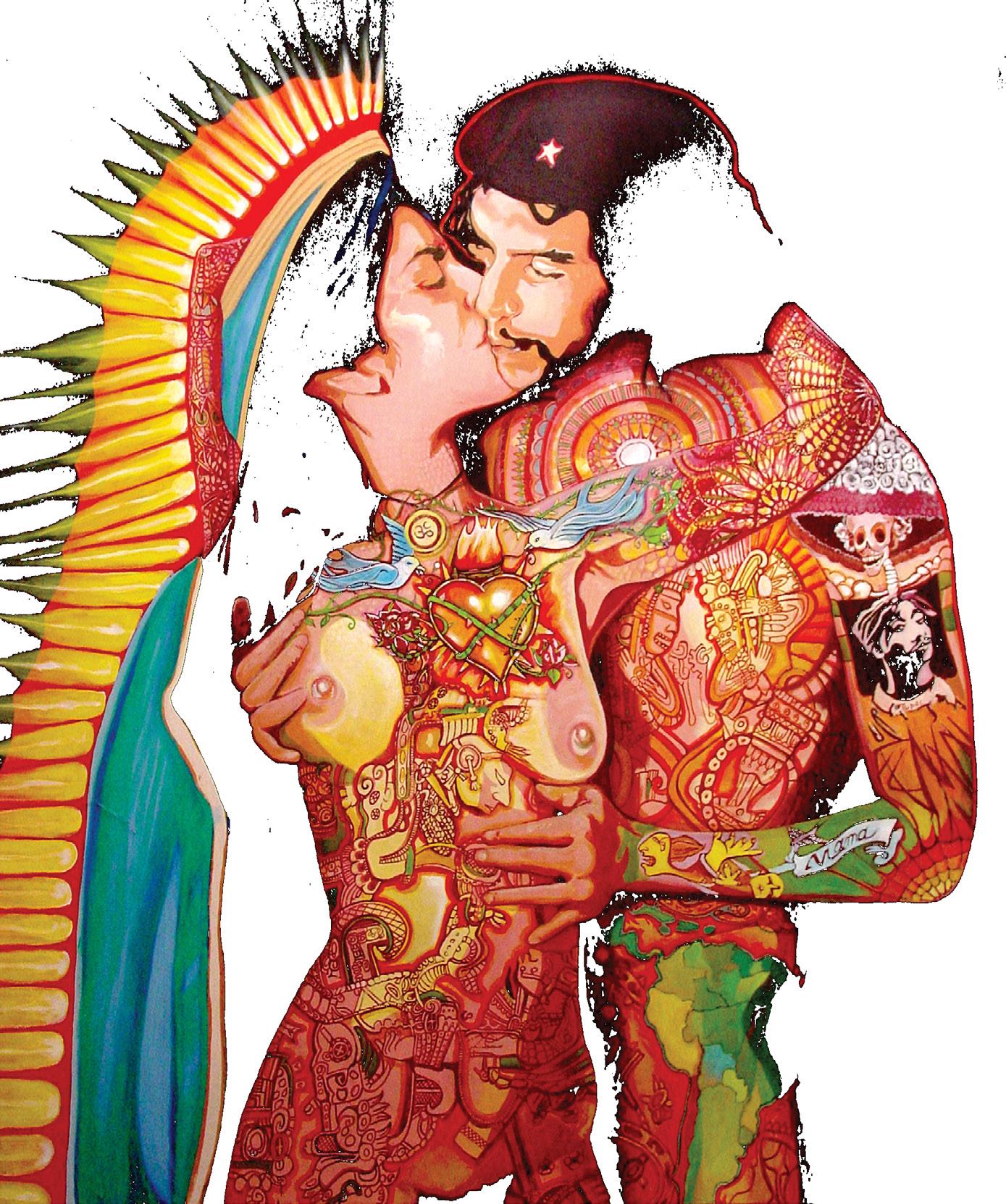
Saturday, October 17 9 Am - 6 pm in Room 121 Dodd Hall, UCLA Admission Free
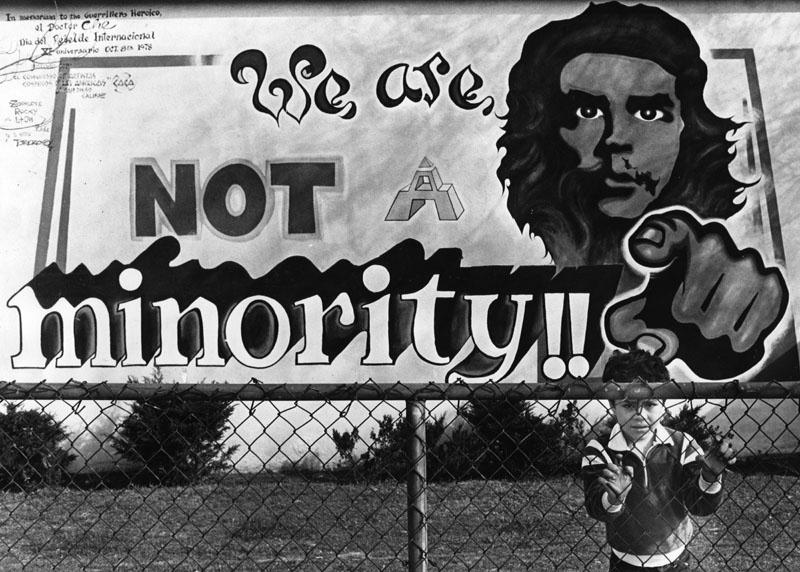
(Mario Torero, Mural, Estrada Courts)
8.30 am Coffee, tea, & pastries
9 am Welcome and short introduction, David Kunzle (Professor of Art History, UCLA)
9.15 am Roberto Massari (author, publisher, Founder and President of the International Ernesto Che Guevara Foundation, Italy)
9.30 am Maurice Zeitlin (Professor of Sociology, UCLA), How I Met Che Guevara
9.45 am Luiz Pericàs (Professor of Sociology, Uni. of São Paulo), Che Guevara, the Cuban Revolution, and Brazil
10.30 am Margaret Randall (Poet & Latin Americanist), Che on My Mind
11.15 am Coffee break
11.45 am Christine Sellin (Professor, Cal. Lutheran Uni.) in dialogue with Becca Wilson (daughter of Che! screenwriter Michael Wilson), Che! : How “One of the Ten Worst Films Ever Made” Got Made and Unmade
12.30 pm Lunch break
2 pm Michael Casey (author & researcher), Che: The Afterlife
2.45 pm David Kunzle Chesucristo: Poetry and Imagery of Che’s Christification 3.30 pm Roberto Massari, The Ethics of Che
4.15 pm Tea break
5 pm Fabian Wagmister (Professor, Dept. Motion Pictures, TV and Digital Media, UCLA), Installation: Two, Three Many Guevaras
5.45 pm Wrap-up
Sponsored by: Dean of Humanities, Latin American Institute, Departments of: Art History; Film, TV and Digital Media; History; Sociology; Spanish and Portuguese. Resource: Center for the Study of Political Graphics, Los Angeles.
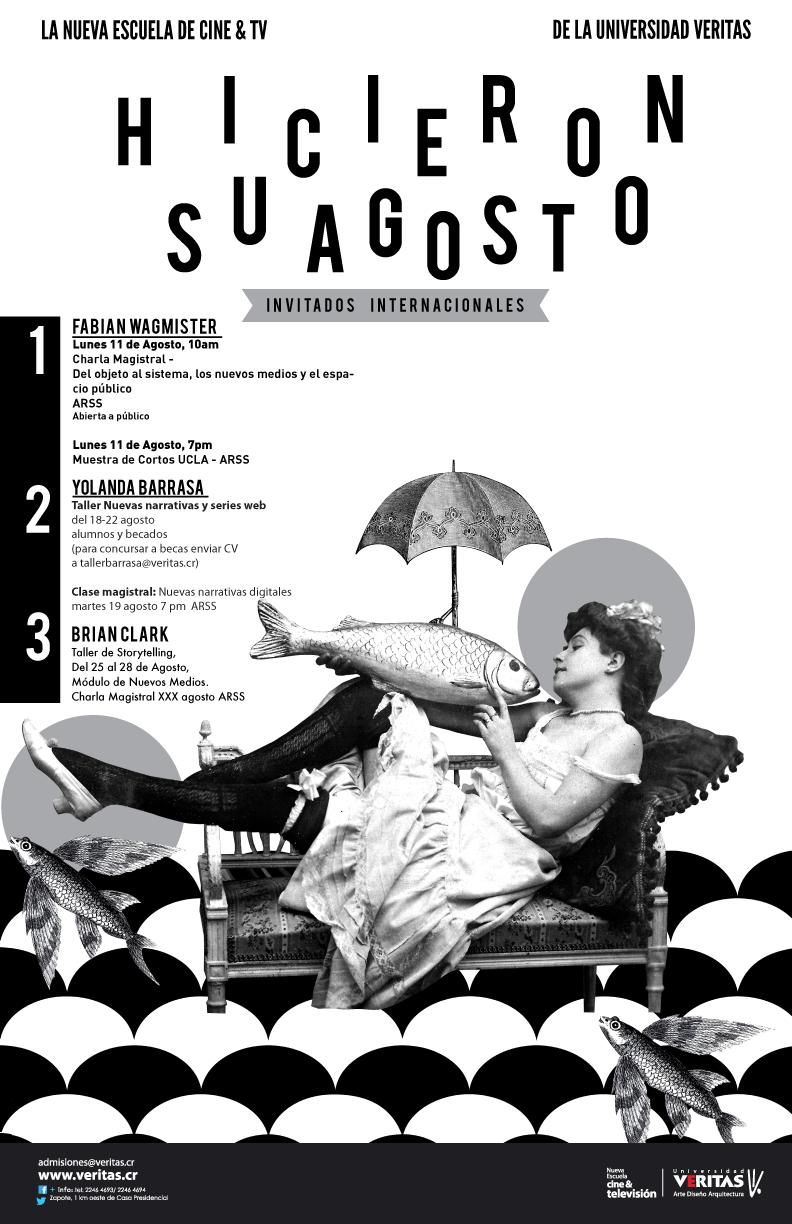
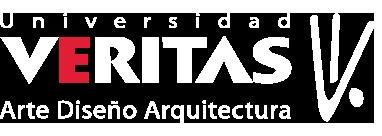
#EXPERIENCIAVERITAS, ESCUELA DE CINE Y TELEVISIÓN Fabián Wagmister de la Facultad de Cine de la UCLA inaugura la Semana de Cine Nacional de la NECTV
by Universidad Veritas • febrero 20, 2014
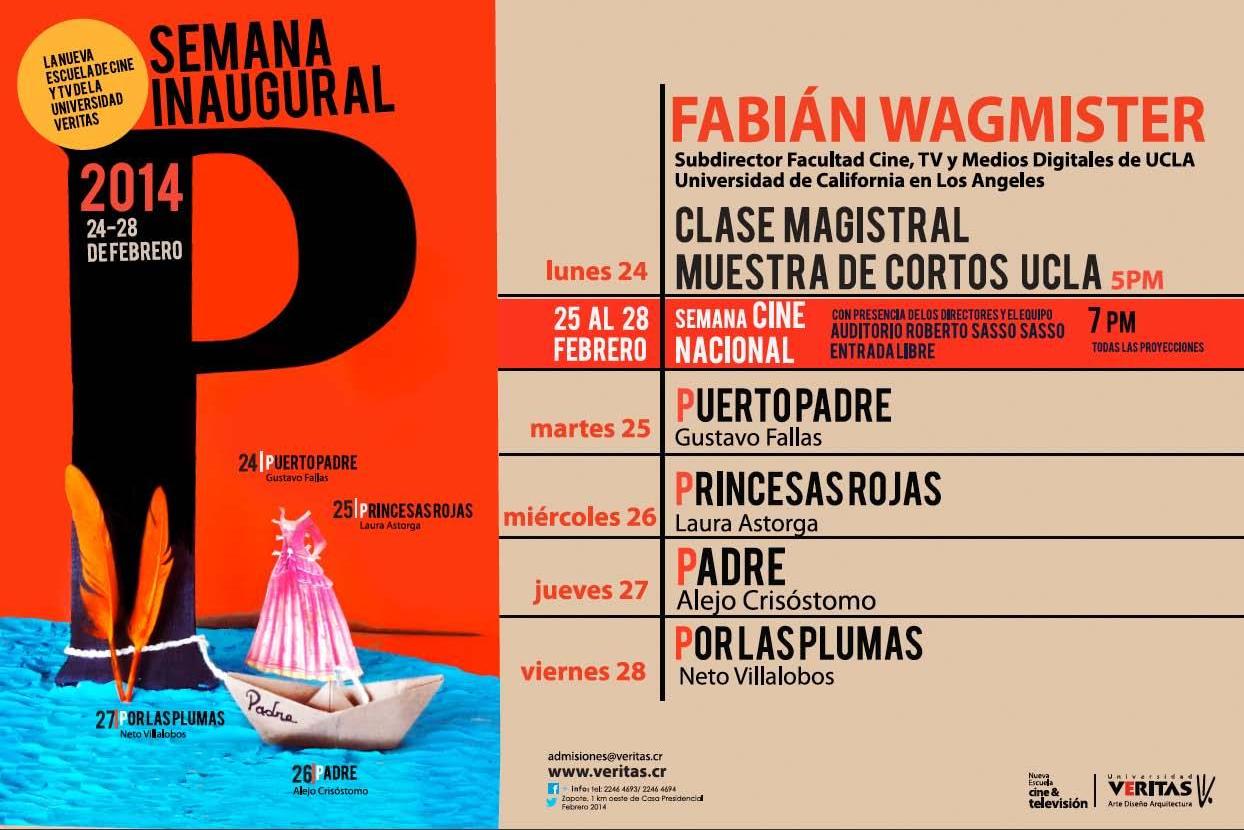
Por la puerta grande inicia su curso lectivo la Nueva Escuela de Cine y TV de la Universidad VERITAS. La Semana Inaugural abre el próximo lunes 24 a las 5 p.m. con una charla abierta del invitado internacional Fabián Wagmister, subdirector de la Facultad de Cine, TV y Medios Digitales de la prestigiosa Universidad de California en Los Ángeles (UCLA).
El especialista en nuevos medios, fundador del programa de Culturas Digitales y profesor de creatividad audiovisual y artista de medios digitales, Fabián
Suscribirse
Reciba notificaciones en su correo eletrónico
Buscar …
Entradas recientes
Estudiante de VERITAS diseñó stand de Holcim para ExpoConstrucción Fabián Wagmister de la Facultad de Cine de la UCLA inaugura la Semana de Cine Nacional de la NECTV Carlo Guillermo Proto presenta su premiado documental “El Huaso” en VERITAS Aprenda a tratar imágenes con Photoshop Mensajes en movimiento: El arte de la tipografía cinética. Charla con Dan Boyarski.
Esta actividad es el abrebocas de la Semana de Cine Nacional, un festival de cine costarricense que incluye proyección de una película tica por día con la presencia del director/a y parte de sus equipos de rodaje y producción.
Cada día del 25 al 28 de febrero se celebra la Semana de Cine Nacional, en el auditorio Roberto Sasso Sasso de la Universidad VERITAS, habrá película y posterior conversatorio con el director/a y parte del equipo que trabajó en el largometraje.
El calendario es el siguiente:
martes 25: Puerto Padre de Gustavo Fallas;
miércoles 26: Princesas Rojas de Laura Astorga;
jueves 27: Padre de Alejo Crisóstomo;
y viernes 28: Por las plumas de Neto Villalobos.
Todas las películas a las 7 p.m.
La entrada a todos los eventos es libre y gratuita. La Universidad VERITAS se ubica 1km al oeste de Casa Presidencial en Zapote. Más información al 22464846
Iván Delgado en Workshop Barrio del Astillero: Rethinking diverCity Ligia Córdoba Barquero en Workshop Barrio del Astillero: Rethinking diverCity Madelaine Martínez Rojas en Bienvenidos al blog de nuestra Universidad Gabriela Villalobos en Caracol de Plata 2013 Juan Carlos Porras M. en Caracol de Plata 2013
Archivos
febrero 2014 enero 2014 diciembre 2013 noviembre 2013 octubre 2013 septiembre 2013
FABIÁN WAGMISTER
Subdirector de la Escuela de Teatro Cine y Televisión de la Universidad de California en Los Ángeles. Uno de los fundadores del Laboratory for New Media, un entorno curricular para la creación y desarrollo de estéticas digitales. Enseña creatividad audiovisual y es fundador y director del Programa de Culturas Digitales del Latin American Center de UCLA. Ha sido colaborador del Instituto de Identidad Cultural, Arte y Tecnología de Costa Rica y del Centro de Arte Digital de la Universidad Patagónica de las Artes (Argentina). También fundó y es el investigador principal del HyperMedia Studio de la UCLA.
Compartir Facebook 50 Twitter 6 Pinterest Google
Correo electrónico Tumblr LinkedIn Reddit StumbleUpon
Imprimir
Me gusta: Me gusta
Se el primero en decir que te gusta.
Tags: Fabián Wagmister Nueva Escuela de Cine y TV Semana Cine Nacional
veritas
Categorías
#ExperienciaVeritas Desde la Presidencia Escuela de Animación Digital Escuela de Arquitectura Escuela de Cine y Televisión Escuela de Diseño de Interacción Escuela de Diseño de Moda Escuela de Diseño de Producto Escuela de Diseño del Espacio Interior Escuela de Diseño Publicitario Escuela de Fotografía Uncategorized
Blogs que seguimos
